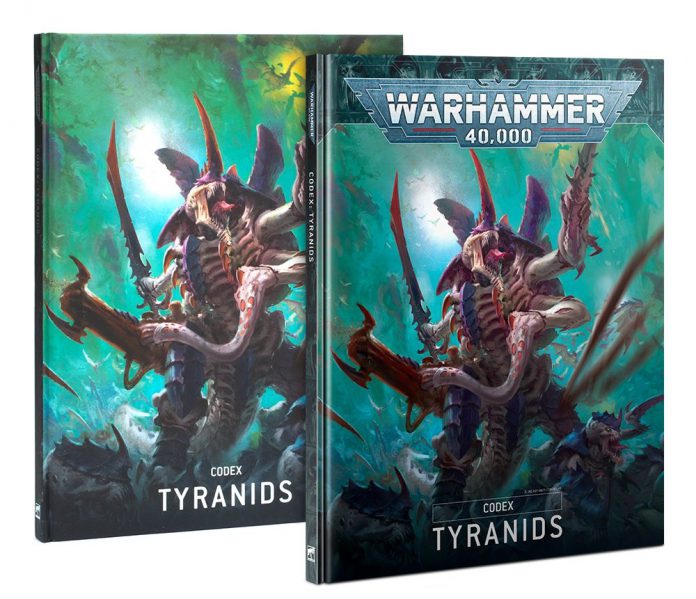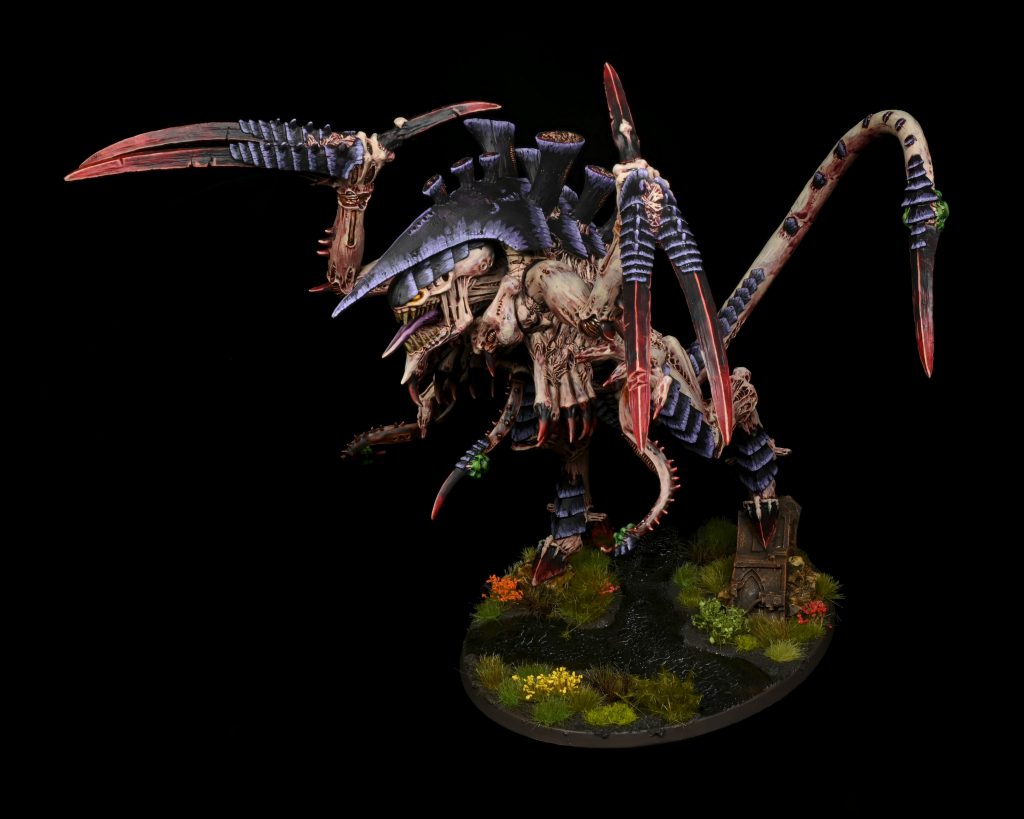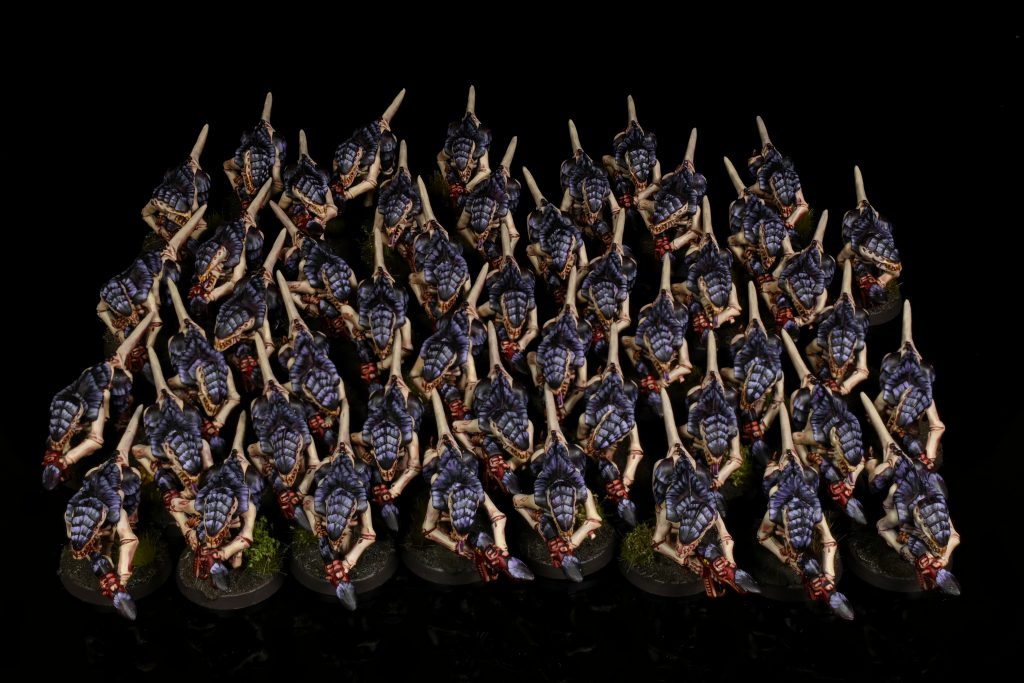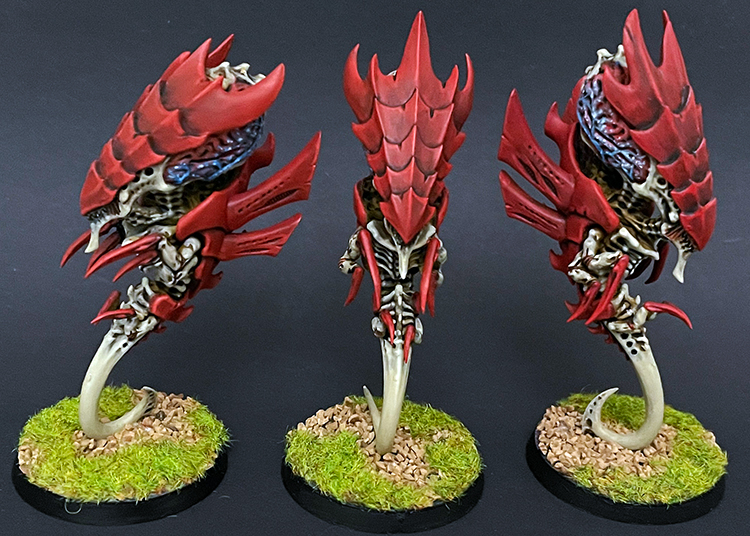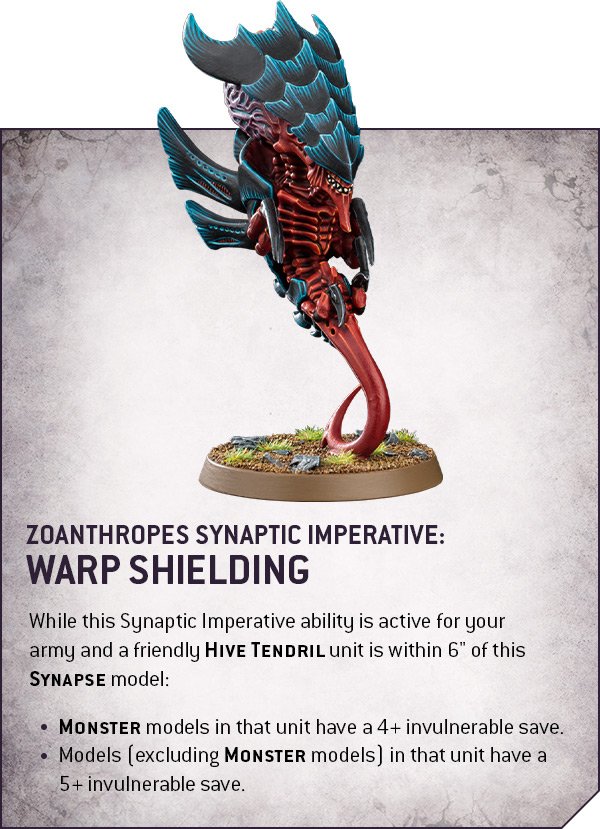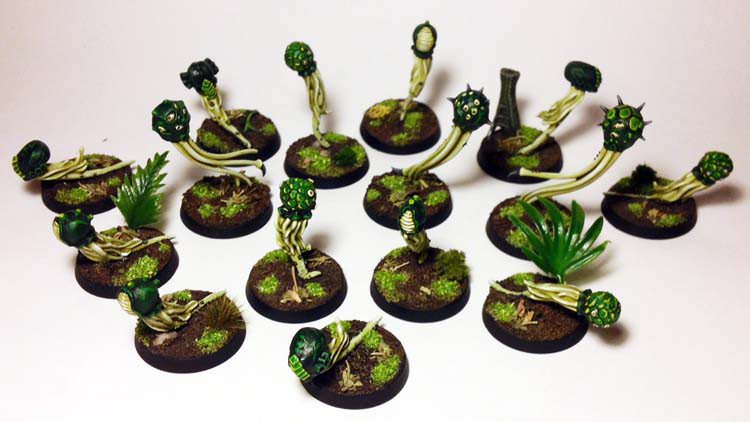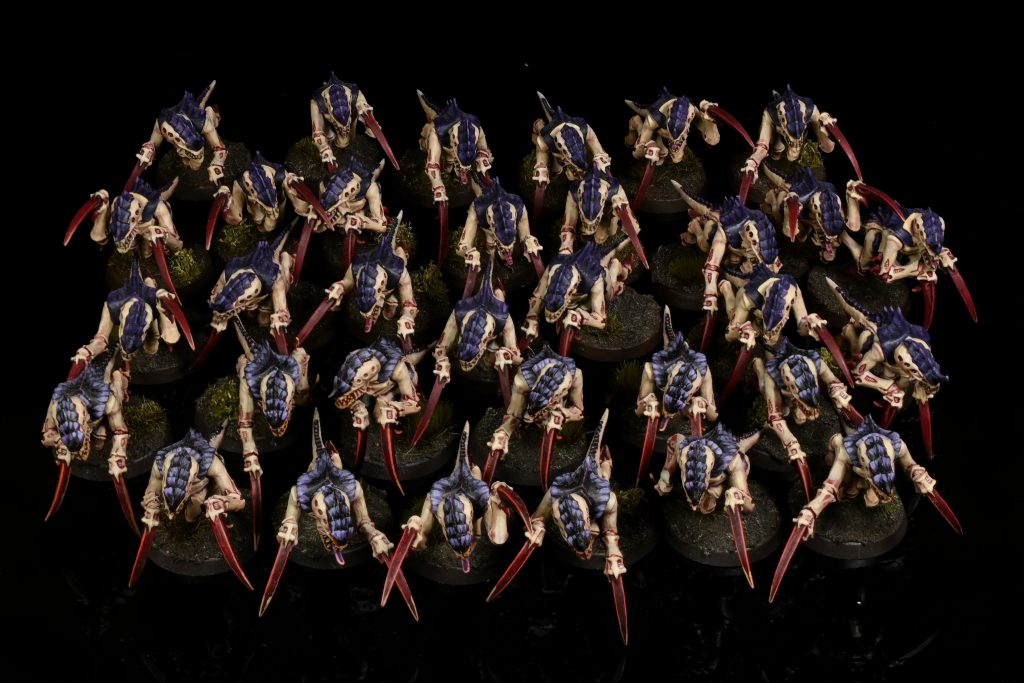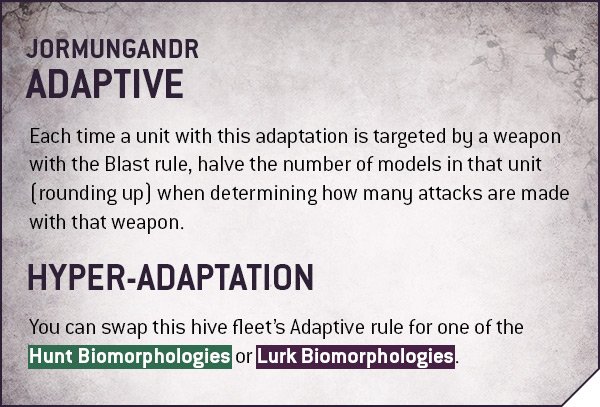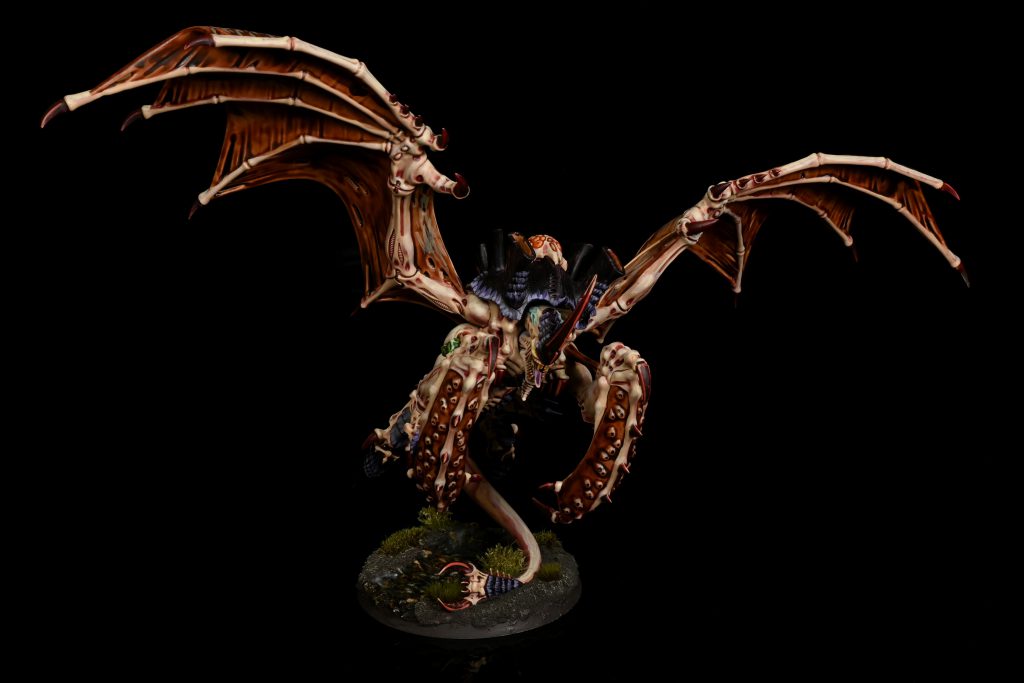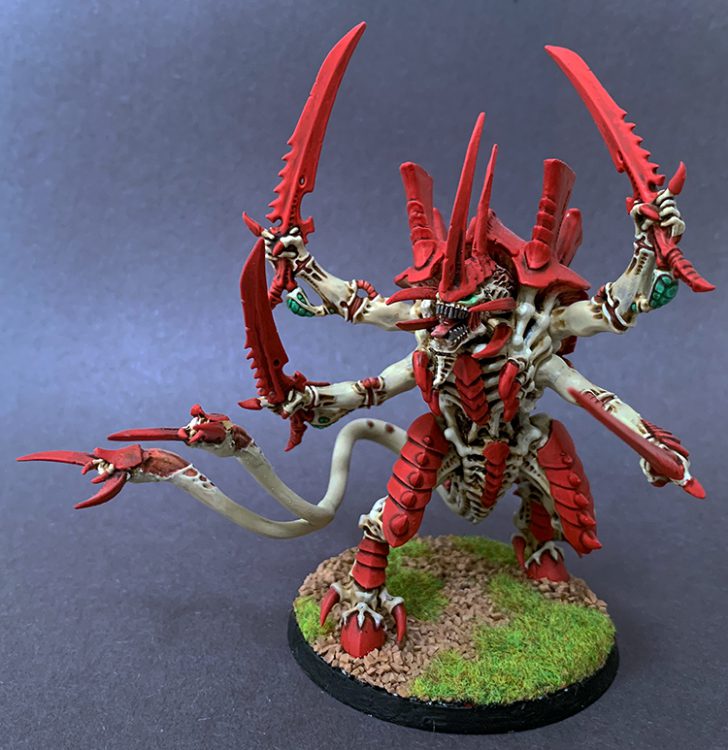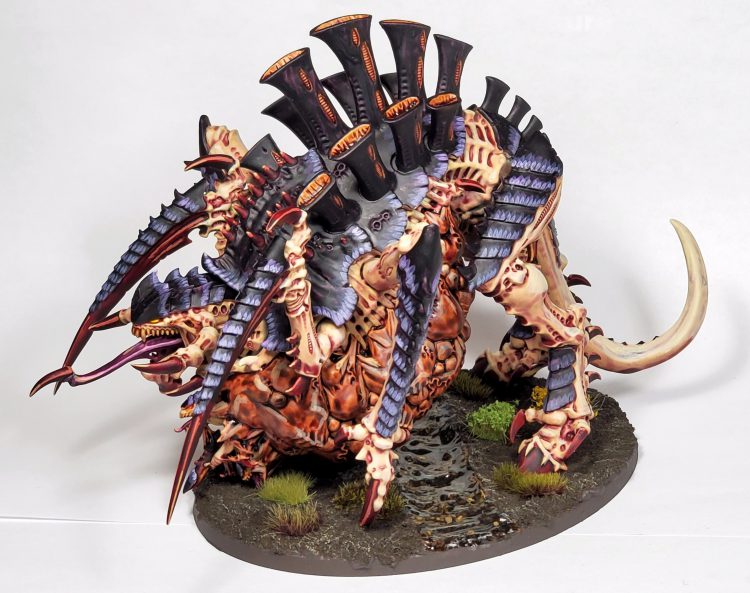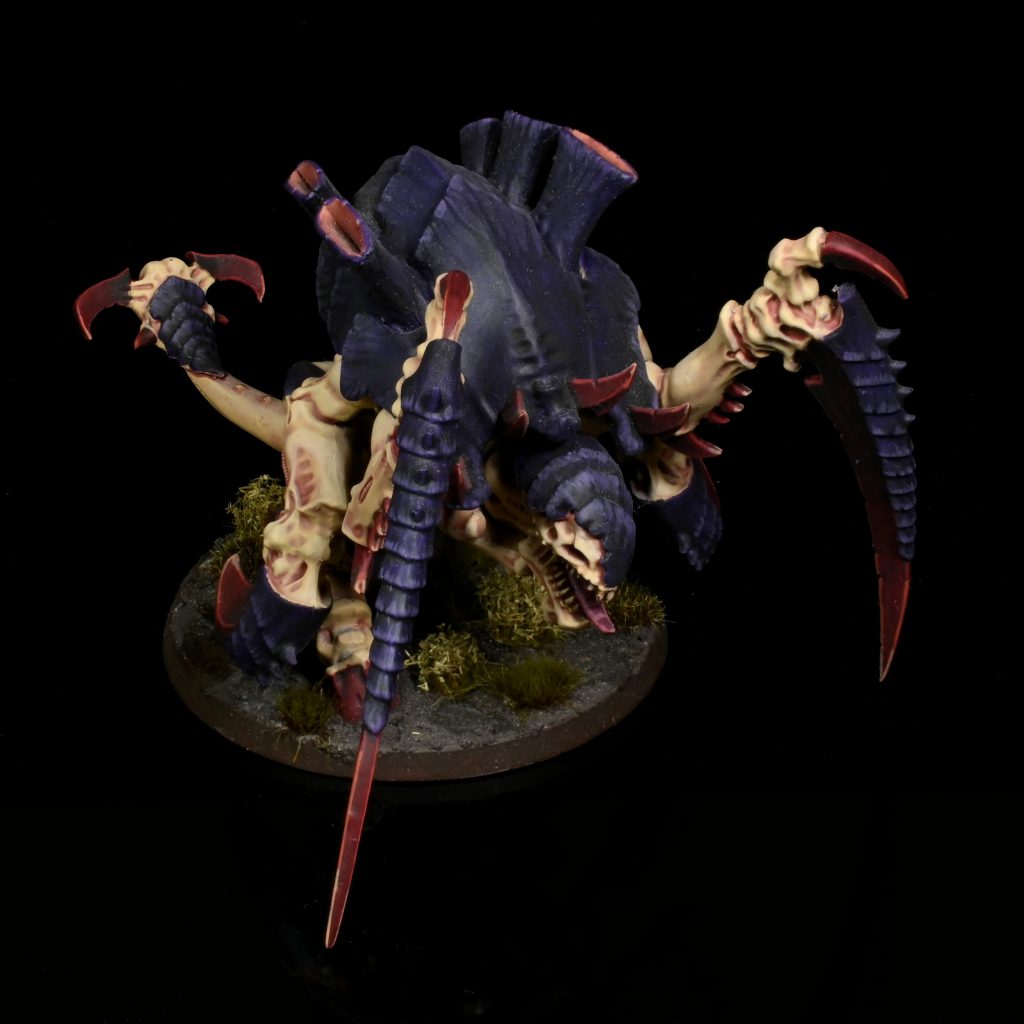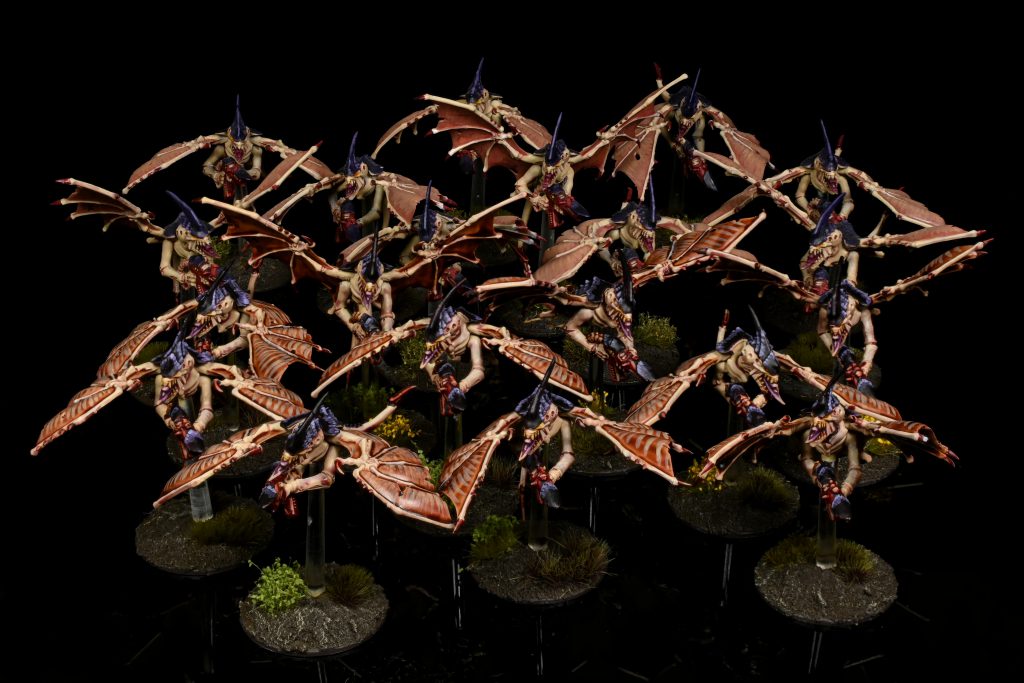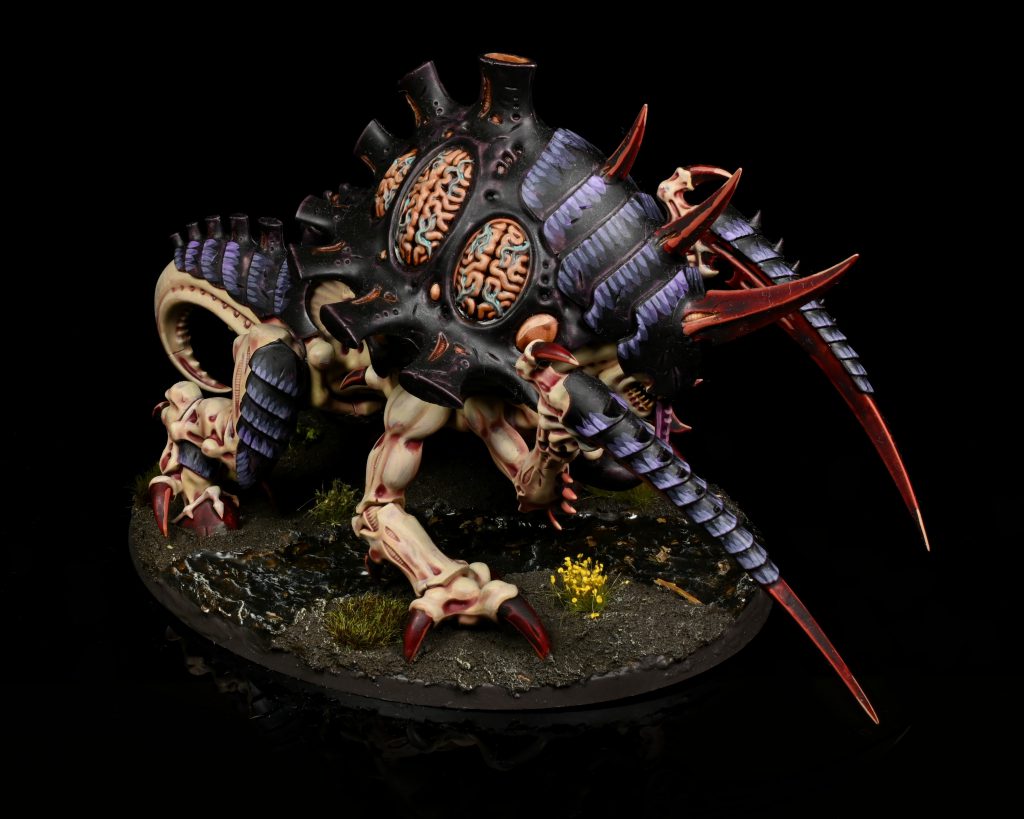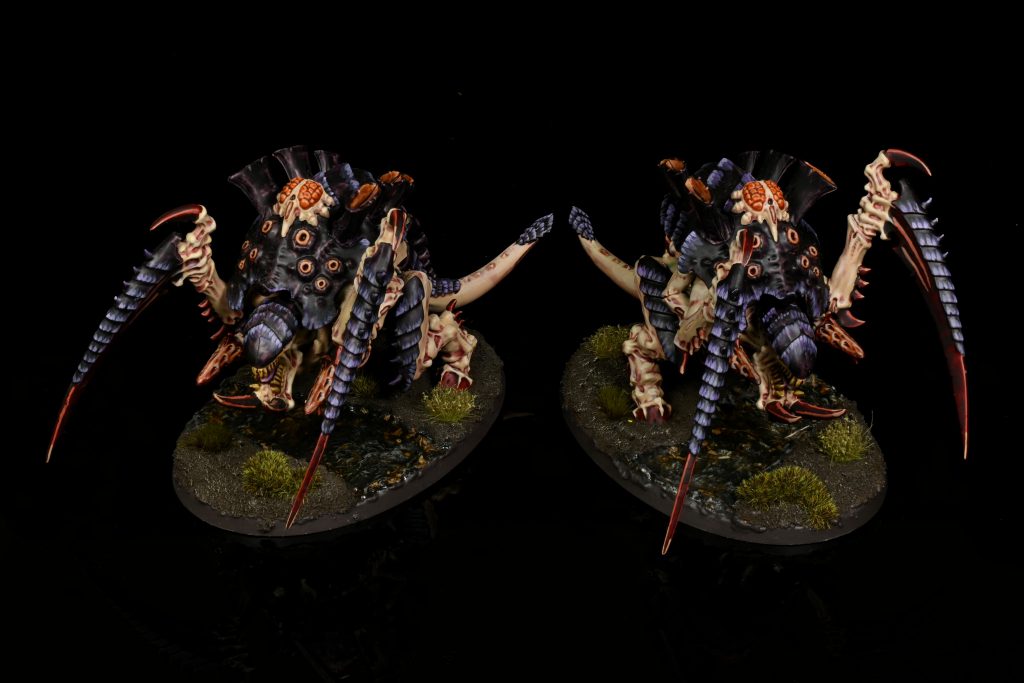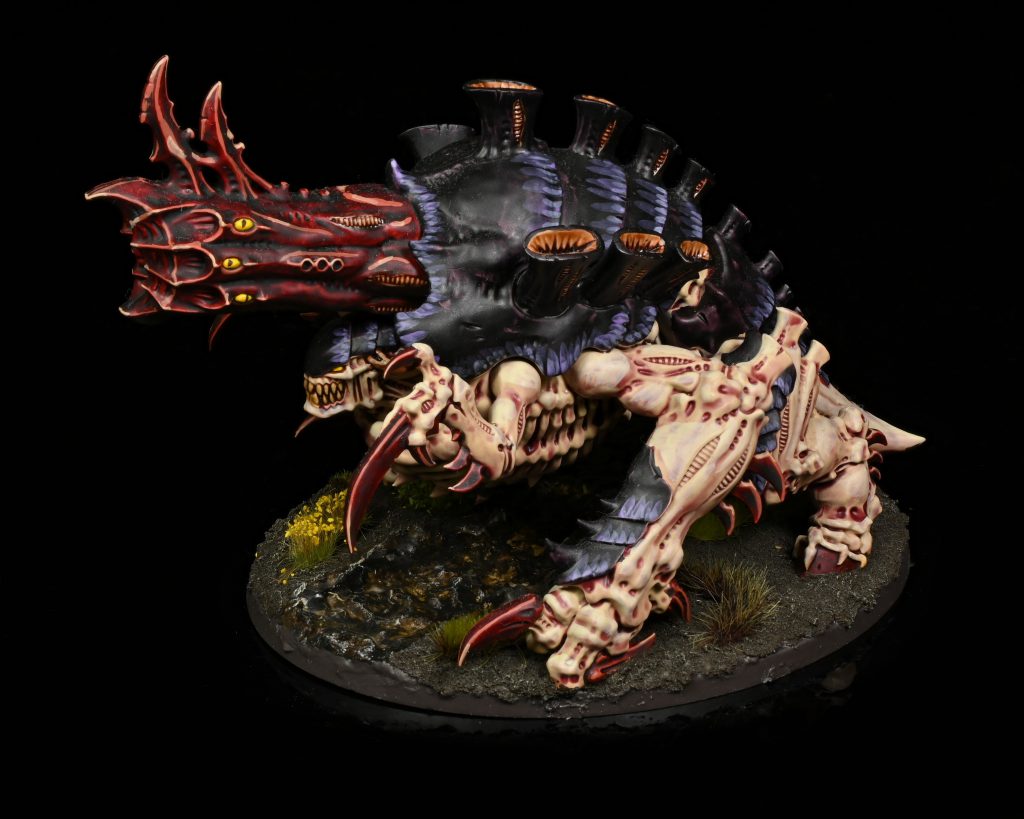Do the pointless squabbles of the galaxy’s many races bore you? Do you think all that energy they waste fighting one another could be put to better use as biomass? Do you want to unleash a horde of terrifying monstrosities and chittering, bladed bugs to make that a reality? If so, then good news – with a great thundering of chitinous feet, the 9th Edition Tyranid Codex has arrived, bringing improved datasheets, new tools and some terrifying combos to a tabletop near you. The Hive Mind hungers, and the prey had better watch out.
To find out just how doomed the galaxy is, I am joined by Tyranid fans Gunum, PierreTheMime and Primaris Kevin, all of whom are eagerly looking forward to throwing down with the new book, and we’re going to take a look at the army rules, the datasheets and round off with some final thoughts and army lists to really get your appetite for delicious biomass going.
We would like to thank Games Workshop for sending us a review copy of this codex.
Why Play Tyranids?
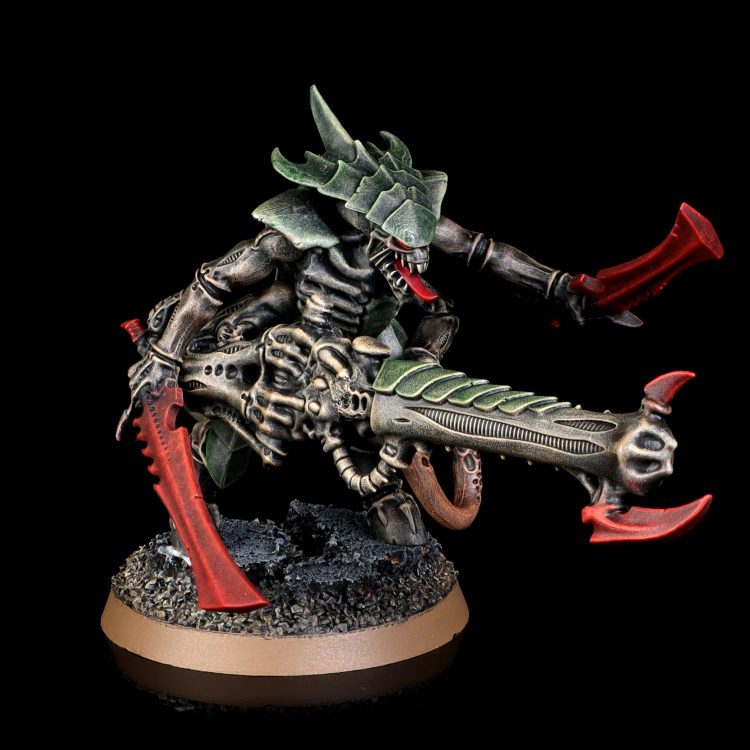
Credit: Pendulin
Tyranids are all about the monsters – swarms of lesser bugs might accompany them to war, but the big draw here is the ability to throw shockingly powerful hammer blows from your chunkiest creatures, often at alarming speed. Whether you want to dominate the Shooting, Psychic or Fight phases this book has got the bug for you, with plenty of potent tools for powering them up, including strong army-wide buffs from the new Synaptic Imperatives. Many also have unique tricks they can pull off to help you adapt to situations on the tabletop. You’ll find this army rewarding if you want to throw a daunting wall of chitin at your opponents and draw on a flexible pool of powerful abilities to ensure that their resistance is futile.
What’s in this Book?
- Lore for the forces of the Hive Mind, and the various tendrils that have struck into known space.
- Rules for constructing a Tyranid army, including new customisable Hive Fleet Adaptations.
- Adaptive Physiology and Synaptic Imperatives, allowing you to customise your monsters before and during the battle.
- Crusade Rules, letting you work through the process of devouring a whole entire planet.
- All the stratagems, warlord traits, relics and secondary objectives you’d expect from a 9th Edition book, plus an updated Hive Mind psychic discipline.
- Datasheets for all Tyranid units.
The Five Best Things About This Book
- Synaptic Imperatives: Powerful, flexible and flavourful, Synaptic Imperatives represent the shifting will of the Hive Mind on the tabletop, helping your army adapt to whatever is thrown at you.
- Monsters: This book is all about the big bugs, with most of them getting substantial improvements compared to the eighth edition, making them the powerhouses they should be on the tabletop. Especially Carnifexes.
- Customisation: The Tyranids constantly adapt to better devour their foes, and the strong relics, warlord traits and flexible effects in the book really sell that, especially the Hyper Adaptation rule.
- Hive Fleets: Nowhere is that more true than with the Hive Fleets, with one of the most exciting faction customisation mechanics we’ve seen so far.
- Deathleaper: It’s after you. Good lord is it after you.
What About Crusade?
Today’s review focuses on the part of this book that are relevant to matched play. If you want to find out how you go about devouring a whole entire planet for fun, profit and biomass make sure to check out our Crusade review on Tuesday.
What About Crusher Stampede?
Oof, OK. The short version is that if Crusher Stampede stays unchanged then the lists unleashed by this book are going to be Harlequins-level broken at minimum. We really don’t want to spend the whole review of this new book talking about how Crusher Stampede pushes every single datasheet and ability all the way to 11, and there’s almost no need to – just jam together Hive Tyrants, Maleceptors, Harpies and Carnifexes and go wild, it really doesn’t take much more thought then that. We’ll have a Crusher Stampede list at the end for people who really want to live the dream, but otherwise basically just assume every monster and every possible thing you can do with the monsters is incredibly strong with Crusher added on.
Primaris Kevin: As awesome as the Hive Fleet Adaptations are, none of them hold a candle to giving a 5++ and reducing incoming damage by 1. It synergizes with Maleceptors (more powers), makes every monster significantly harder to kill, makes the Synergistic Imperative of Zoanthropes less necessary, has a lot of powerful traits and Stratagems, and has minimal downsides.
The Rules
Detachment Rules
Like most armies in 9th Edition, Tyranids start off with a set of Detachment Rules, granting Objective Secured to their Troops, restricting their most powerful leaders (here HIVE TYRANTS) to one per detachment, and unlocking Hive Fleet Adaptations if every unit shares a Hive Fleet, excluding LIVING ARTILLERY units. They also have a new HIVE TENDRIL faction keyword that appears on all units in order to distinguish them from the Genestealer Cults.
Of note on that point, the wording for Hive Fleet Adaptations in the Detachment Rules section is different than normal, and currently requires every unit in your army (rather than “every HIVE TENDRIL unit in your army”) to share a subfaction to unlock them, so currently taking a Genestealer Cult detachment turns off these bonuses. This may change or be ruled not to apply, as the wording later in the book is standard, and this is harsher than other restrictions we’ve recently seen, but bear that in mind when planning lists.
Army-wide Rules
Synapse
The will of the Hive Mind is transmitted by a synaptic network, and many of the more powerful monsters (and some smaller creatures like Warriors) act as nodes and relays for this. These units have the SYNAPSE keyword, which has the immediate benefit that HIVE FLEET units within 6” automatically pass morale, and some additional utility beyond that. SYNAPSE units can also act as part of the chain for a Synaptic Link, and each Synapse unit has a unique Synaptic Imperative ability that you unlock by including them in your army.
For the basic Morale effect, this is a shorter radius than we’re used to from 8th Edition, so keeping big swarms of gaunts in range of Synapse units is sometimes going to take a bit more thought – but is still extremely handy.
Synaptic Link Range
As debuted in Octarius, some Tyranid abilities available to SYNAPSE units can be used on any target within Synaptic Link range. In Octarius this was specific to a set of command phase buffs, but in the book it’s been rolled out a bit wider – most notably to some of the psychic powers.
Synaptic Link range is, by default, 12”, but you can “bounce” this onward from any other SYNAPSE unit within range of the originator. For example, if a Hive Tyrant wants to use a Synaptic Link ability, and has a Zoanthrope within 12” of it, then it can pick a target that’s either within 12” of itself or within 12” of that Zoanthrope. That can be chained along more than one model, so if you space out your Synapse units carefully then plenty of the table will be under your influence. This is particularly good with a Harpy with the Synaptic Enhancement Adaptive Physiology, giving you an inexpensive and highly mobile relay node.
Something that’s completely new here is a number of the psychic powers available to the Hive Mind now use Synaptic Link range, which can make your psychic phase quite a bit more effective if you’ve properly arranged your SYNAPSE models but could bite you if you make a mistake in positioning or your canny opponent breaks your link chain. This is a cool mechanic and adds a new wrinkle to your opponents target priority.
Synaptic Imperatives
Synaptic Imperatives are the new monofaction bonus for Tyranids, and give you access to a pool of effects you can draw on based on which SYNAPSE units you have in your army. At the start of each Battle Round, you pick one of these from a unit that’s on the Battlefield (or a destroyed one using the Synaptic Legacy stratagem) and that you haven’t picked before, and it becomes active. Friendly units within 6” of all of your SYNAPSE units then get a benefit (though note that this is specifically not an Aura).
Some of these are clearly extremely strong right out of the gate – the Zoanthrope’s Warp Shielding being a first pass standout that gives MONSTER units a 4+ invulnerable save and everyone else a 5+. In the highly lethal world of 9th Edition, this is a fantastic thing to be able to throw up if you go second. Also on the Psychic theme, if you just want to blast your opponent straight into the (or stop their plans to do the same to you) you have the Neurothrope’s Psychic Augmentation, boosting your casts and denies by 1, and also granting a 5+ against mortals. Finally for big brainy bugs, the Maleceptor’s Psychic Oversight provides substantial support for performing Actions of all stripes, letting units that fell back or Advanced perform normal Actions, Shooting not to break Actions, and units to perform Psychic Actions as well as casting their powers. That last one is extremely good for the Maleceptor themselves, because as we’ll see when we look at their datasheet, you really want to be jamming out a lot of powers and Actions. Dominating the Psychic Phase looks like something that Tyranids will excel at, and this suite of tricks is going to be a lynchpin in lists built around doing so.
If psychic dominance isn’t your jam (and why not, what sort of Hive Mind are you running over there) there are plenty of other strong effects too. Plenty of the effects we see lots of in 9th like exploding 6s to hit in Shooting or Melee are here, along with Fall Back and Charge from the Hive Tyrant (who being real, you’re pretty much always bringing) and Light Cover in the open from the Broodlord (upgrading to Heavy Cover too if you’re already in Light). There are also a few speed boosts, always welcome, and probably the funniest and most unique of the lot in Thrashing Demise from the Trygon Prime, which lets any of your models with Death Throes trigger it on a 3+ rather than a 6+, and also lets anything without that ability deal a mortal back on a 6 when they die.
The basic vibe we get from this is that the Psychic stuff is going to actively enable you to “go off” in a way that you might not otherwise manage in lists built around it, then various other effects from units you already want in your army like Hive Tyrants are going to provide you with a toolbox to deploy at the appropriate moment. It’s a hugely powerful new rule which gives players a method to react to the turn order and positioning prior to each round and properly applied can be a huge force multiplier. While they’re all pretty solid, we will be very surprised to see any competitive list that doesn’t include at least a minimum-sized unit of Zoanthropes, because Warp Shielding can severely blunt incoming damage and being able to break that out when necessary is worth the cost of the unit alone.
Primaris Kevin: Synaptic Imperative is also really good from the perspective of game management and mental load. The only thing you need to keep track of is which Imperatives have already been used.
Living Artillery
Tyranids are notorious for unleashing living bombs on their enemies in the form of Spore Mines and Mucolid Spores, which can both be included in your army in their own right and spawned by various other effects and units. These don’t get a HIVE FLEET keyword, and also share the Drone Bioform special rule, which makes them work pretty differently to most units. For all intents and purposes, these units work more like a token or marker than an actual model. Opposing units can’t end a move on top of them, but can otherwise move through them unimpeded, they don’t get zoned out by them for Deep Strike purposes, and these units are ignored for mission objective purposes and Look Out Sir. Given that these are living bombs, you won’t be surprised to learn that getting too close to them can have consequences (Mortal Wounds), but they don’t prevent the opponent from generally going about their business. This is both good and bad for the discerning Tyranid player – on the one hand, you can’t do as much janky stuff with these to make your opponent’s life miserable, but on the other the effects that spawn these can now be a bit more pushed and easy to use, as you don’t have to account for the possibility that they ruin the game for the other player.
Gunum: This is one of my big winners when we talk about changes in the book. We have multiple ways to deploy these doom balloons and their explosion timing is different, now exploding when enemy units end their movement near them (or after having moved past them) versus at the end of the charge phase. You are now able to deploy these in locations that would be near places your soon-to-be dinner wants to be in, and do a different kind of zone control.
Shadow in the Warp
A returning classic, the giant, throbbing brains of SYNAPSE units give massive headaches to Psykers of other factions, subtracting 1 from their Psychic Tests within 18” and also causing them to take an extra mortal wound if they suffer Perils. Warlocks everywhere are weeping.
Death Throes
Big bugs are essentially the Tyranid equivalent of tanks and everyone knows what happens when tanks die – they explode. Fools and charlatans will tell you that this happens pretty rarely, but experts agree that the one out of six dice roll for causing a tank to explode comes up nine times out of ten. It’s just science.
In 8th Edition, Tyranid Monsters had Death Throes, explosions by another name. The name stays, but the effect has been tweaked a bit. Now, instead of affecting units in a radius, when these trigger (still usually on a 6 unless boosted) they only deal mortal wounds to the nearest enemy unit within the range. This can sometimes be a sidegrade, as games absolutely can be flipped by one of your units going bang in the middle of the enemy army at a key moment, but the change removes the big drawback of explosions, which is that they’ll sometimes completely ruin you when the opponent gets a strong start and pops a few units in your deployment zone.
Wings: I am writing after a day of GT play where I have had badly timed vehicle explosions result in the annihilation of key characters two games running, so this is looking pretty good from where I’m sitting.
Swarming Masses
Some monsters are big and chunky, others are small and highly numerous. Carpets of Gaunts are an iconic part of the Tyranid army, but one of the challenges with them has always been getting enough bodies into a fight for their numbers to be a factor. This rule allows your horde of critters to fight so long as they are within 2 ½ inches of an enemy model, so with some proper arrangement a large unit of bugs on 25mm bases should be able to get three “ranks” into combat.
Death From Below
Applying to the various writhing snake-like beasts in the book, this allows the option for a classic “deep strike” as units spring out of ground and cause havoc. Units that gain this rule also gain a BURROWER keyword, which can be used for a handy stratagem.
Hive Fleets
Hive Fleets are the Tyranid subfactions, granting a Hive Fleet Adaptation to your units, warlord traits, relics, stratagems and (for Tyranids) a free additional Psychic Power that all PSYKERS know for free. Not only that, but this book debuts a new spin on subfaction customisation, and this one rules, because as well as being able to build your own Hive Fleet from scratch, you can also customise the named Hive Fleets using the Hyper Adaptation rule.
Hyper Adaptation
Like most modern faction traits, Hive Fleet Adaptations have multiple effects. For Tyranids, one of these is labeled as Adaptive, and as a pre-battle ability you can swap this effect out for a choice picked from one of the three custom trait lists. Each Hive Fleet can draw on two of the three lists, and this gives you a wealth of ways to adapt to what you’re facing on the table. The Lurk list really stands out, but all three have some good choices, and because of Hyper Adaptation existing we’re going to flip our normal script and talk about the custom trait options first.
Custom Traits
The available custom traits are split into three lists, Hunt, Lurk and Feed with five choices each, and if you’re building your own Hive Fleet you pick one option each from two lists, and declare one of your picks to be your “adaptable” trait, which can be swapped out for a selection from the third list at the appropriate moment. That means you effectively get one free pick, and then get to select your other trait out of a list of six game to game – certainly not bad.
As mentioned above, Lurk seems very strong, and has what’s probably the biggest standout game changer is Territorial Instincts, which gives Objective Secured to MONSTER units, and also lets them count as five models for objective control if they have a wound characteristic of 10+. This is obviously fantastic if you want to take lots of monsters (you do), as it makes it harder for opponents to exploit your low model count to out-primary you, and harder to push you off key points when it really matters. Lurk also has two excellent situational picks in Exoskeletal Reinforcement (change incoming AP-1 to AP0) and Synaptic Ganglia (re-roll denies, +3” to Psychic Power ranges). The former is great if you’re up against something with volume AP-1 like Tau, and the latter can cause headaches for armies like Thousand Sons or Craftworlds.
Hunt (as the name suggests) has some strong mobility picks – army wide Heroic from Ambush Predators seems extremely good for Carnifex-heavy lists, and if you’re building a bit more in a dakka direction with them then Heightened Reflexes (fall back and shoot at -1) could be good as well. Less complicated but still strong is Augmented Ferocity for +1” to charges – something to consider if you’re packing lots of Deep Strikers. Honestly none of this list is bad as the last two are both interesting – Synaptic Goading gives a 6” pre-game move to Endless Multitude models, which is strong in a vacuum but held back by these generally being slightly underwhelming, and Gorgon (the fleet that really wants this) not having access to this list. Finally, if your swarms have got amongst the enemy, boosting their consolidation with Adrenalised Onslaught is also good, but you’re probably more interested in the effects that get you to battle in the first place.
Finally, Feed is maybe a bit weaker overall, but still has some draws. Unstoppable Swarm isn’t super flashy, allowing you to ignore movement and charge penalties, but up against some of the top armies in the meta this is actually an effect you want, so being able to flex it on isn’t bad. Also interesting is Relentless Hunger, letting you make a 3” move when you fail a charge, perhaps allowing you to skulk back into cover or push far enough to claim an objective. There’s also some Overwatch suppression and boosts to shooting here, which are nice but probably don’t end up as the things you need.
It feels like any custom fleet is very likely going to be built from Hunt and Lurk, and access to these is generally useful for Hyper Adaptation purposes (and all fleets have access to at least one of the two).
Behemoth
Behemoth feel like all-rounders – nothing here seems immediately busted, but there’s definitely utility. Their fixed trait gives them +1S in the first round of combat, potentially handy both for pushing big beasts to the key S8 or 9 break points and jumping smaller stuff to S4 or 5. It means combat will never be safe against this faction, which is as it should be for bugs. The Adaptive trait helps that Combat happen, providing you with charge re-rolls, which is fine but not spectacular – there are going to be cases when you’re trying to land two or more tricky charges in a turn and it will help, but if you’re focused more on a few big nasties then switching out for the +1” charge from Hunt (which you can do) and using a Command Re-roll might be better. Lurk is also available to Behemoth.
The trait, relic and power all combine incredibly well on a a Trygon Prime – these get a mighty 12 attacks now, and the relic can push these to D3, the warlord trait gives mortals on 6s, and the Psychic Power applies +1 to wound in melee – a lethal combination. None of these effects are bad on other things too, and indeed +1 to wound in melee off the psychic power is an extremely strong effect to be handing out in general. An early thing worth calling out with that is that far fewer things in this book are CORE-locked than normal – some effects still are, but many toys (including this power) are generally applicable. Carnifexes are CORE, mind, so even when you are restricted there’s still fun stuff to do!
The stratagem here also has real uses – Unparalleled Ferocity lets a non-CHARACTER INFANTRY unit Fight on death for a phase for either 1 or 2CP depending on whether they’re a small or medium gribbly. Making your opponent pay to take you off a point is always good, and can be especially strong into fragile but deadly units like Aeldari melee killers. In combination with the Psychic Power, this maybe also encourages you to bring one big unit of Hormagants, throw them at the enemy with boosted wounds and strength to carve something up on your turn, then annihilate anything that tries to counter-attack in melee. Some armies will just shoot them, of course, but if your opponent is leaning on melee to do damage it’s bad news.
Not a bad start overall – certainly some toys to work with here.
Kraken
The Hive Fleet with a need for speed, 9th edition Kraken eschews its ability to fall back and charge (which you can thankfully access elsewhere) and gains a new lethality on the approach in the form of Questing Tendrils, bumping melee AP by 1 if a unit charges. On hordes this can quickly overwhelm enemy units by pushing enough failed saves and for elite/monster units this can put stronger weapons into no-save land (at least in the few places where invulnerable saves aren’t an option). It’s a decent bump in damage potential, but hinges on actually getting to your enemy.
Kraken’s Adaptive trait ensures your beasts have some spring in their step, improving advance rolls from the normal d6” to 3”+d3”. This definitely improves the chances of getting where you need to be, but there’s very little access to advance and charge now so it’s mostly used for those turns where positioning is key. Like a lot of other traits, this could come in handy but it’s not strong enough that you’re not going to eye some of the other potential Hunt and Feed traits you can swap for before the start of a match.
For the fleet’s unique components, One Step Ahead is completely changed and is now the only ability in the codex to regenerate CP when your opponent uses a stratagem. It’s slightly weaker than similar “for every CP spent by your opponent”-type abilities, but in a Matched Play game on the average it’s still going to hand you back a couple points over the course of a game which is not nothing. Unless you’re really bloated on traits it’s not a bad one to toss on a W10> character so it sticks around for most/all of the game. Synaptic Lure continues the Kraken trend of “closing the gap” by allowing your units to reroll charges against its target. Potentially very handy to mitigate unfortunate low rolls or have another go at a long-bomb charge. Depending on the situation, it’s a little short-range compared to its previous “anywhere on the table regardless of LoS” version but it’s still a decent trick. Chameleonic Mutation got a huge glow-up and will enhance the survivability of the bearer significantly, even in close quarters. Equally important, the relic now disallows rerolls to hit, which a lot of armies leverage to push tons of hits onto targets just by sheer numbers. Overall this means your character is going to have a much greater chance of sticking around and stacking additional hit modifiers with Venomthropes/Malanthrope is also meaningful against armies that rely on +1 to hit buffs to put in real work. Yes, there are potent offensive relics available generally, but those relics won’t help you if your character is a smoking crater before it gets to where it needs to be. Lastly Opportunistic Advance can provide you that extra boost of speed you need to snag an objective or get in range for a surprise offensive. It isn’t going to be applicable to every situation, but is a strong movement enhancement when you need it.
Leviathan
Hive Fleet Leviathan’s days of being one of the most commonly seen Hive Fleets are certainly coming to a middle. Not only do you (presumably) still have the powerful extra tools from their Codex Supplement to play with, they get one of the best Hive Fleet Adaptations in the book. The fixed part of this provides permanent Transhuman (only wounded on a 4+) to all Synapse units and mini-Transhuman (only wounded on a 3+) to other units within Synaptic Link range. This is incredible – opponents are going to sigh deeply as their lances bounce of T7 Flyrants, and it makes a unit of Warriors lurking behind a wall extremely difficult to promptly clear out in combination with Reinforced Hive Node. The Adaptive part is also excellent, being one hit re-roll each time the unit shoots or fights, almost always one of the best faction traits in any book it appears in, and really good here with some of the best units (which mostly carry around heavy venom cannons). It’s particularly useful for Carnifexes since they’re considered individual units after deployment. You’re very keen not to swap this out if you can avoid it, and that matters less than it otherwise might as pretty much the only drawback this faction has is not getting Lurk as one of their choices. Don’t forget that Hive-Mind Imperative from the Supplement can provide ObSec on demand though, so it’s not like they can’t flip objectives when needed.
The other key tool here is the Psychic Power Hive Nexus. This lets one of your units benefit from an extra Synaptic Imperative for a turn, and is both a flexible and potent tool in the abstract, and extremely good at enabling super-powered Maleceptor combos in the specific. The rest of this stuff is fine – Perfectly Adapted as a Warlord Trait provides them with one re-roll per battle round for pretty much anything, the Preceptic Node allows intercept shooting (and is quite generous about it, making a character with it surrounded by shooty Carnifexes genuinely annoying for some lists) and the stratagem lets you get an AP boost if you get multiple units into the enemy.
You’re here for the Adaptation, the Psychic Power and some of the Supplement stuff, and they add up to an incredibly strong subfaction that works super well for most of the more obvious strategies out of the book.
Primaris Kevin: Hive Nexus is an amazing power that offers a ton of flexibility. I feel like it should have been a core power available to everyone. Even if Crusher Stampede and the Supplement end up getting cut this is still a great option.
Gorgon

Credit: Pendulin
Gorgon is clearly built for a horde list, which sadly means that it suffers somewhat from the hordy units in this book maybe being a touch overpriced. The faction trait is very eye-catching though – unless shooting at a VEHICLE or TITANIC, any attack (ranged and melee) made by a unit from this Hive Fleet is successful on an unmodified 4+, very different to anything we’ve seen before and a huge headache for some opponents (Custodes hate this one weird trick). To top it off, you also get one wound re-roll each time you shoot or fight, which can support some of the bigger creatures too. Gorgon can hyper adapt to Lurk or Feed, which is a little bit of a shame as they’re otherwise where you’d like to use Hunt’s Synaptic Goading for a pre-game move.
The rest of their kit leans in on the poisonous theme – their Warlord trait deals Mortal Wounds to nearby enemies in the Fight Phase, their psychic power gives you Mortals on 6s to wound in melee (again great with big units of swarmy stuff) and the Psychic Power enhanced Toxin Sacs, making the auto-wound trigger on a 5+ rather than 6+. The Relic is the only thing that’s a bit off theme, boosting your model’s Toughness and letting them count as having extra wounds remaining when deciding their stats. Not necessary, but being able to make a genuine T9 model by sticking it on a foot Tyrant is cute.
It feels like Gorgon wants you to stack up plenty of Hormagaunts, Genestealers, Raveners, Pyrovores and big units of Tyranid Warriors with high shot ranged weapons, and the resulting army feels like it should be pretty good, but not the best thing this book can be doing and maybe not the best way to run that army in this book!
Gunum: This is one that I absolutely adore. Some of you may have heard that Devourers got a bit of an adjustment, but the hordes of Gorgan care not. Live your Devilguant dreams with this faction and allow a faction that wants to be melee, show you the true meaning of “Just take your 30 saves. AP nothin’“.
Jormungandr
It’s the Sneaky Ones (™). Jormungandr provides Dense at a distance (18” for Monsters, 12” for everyone else) which is, as ever in 9th, fine but not spectacular. The Adaptive trait is cool though – it lets you halve the number of models in units for Blast purposes, which is useless until it massively isn’t, and is thus an ideal use of the Adaptive mechanic. For the many games where you don’t need this, you get access to the strong picks of both the Hunt and Lurk lists, which gives you some options for going fast and options for doubling down on defensive picks as the need arises.
The rest of what’s here is merely OK though, outside the stratagem. The stratagem is a generic deep strike one for a mere 1CP (usable twice in Strike Force), with the only restriction being no TITANIC, so if you want to pick Hunt – Augmented Ferocity as your Adaptive option and stick a couple of Scythed Hierodules or six Screamer Killers in deep strike (maybe with some longer-ranged bugs hanging back) then yeah, this looks pretty good! The Relic is a moderately interesting anti-Action tool, and helpfully goes off after you move (a lot of effects in this book look like some thought has gone into when they should trigger, which is good!), but it’s not special, and if you’re picking this fleet it’s almost certainly because you want to do something horrendous with deep strikers.
Kronos
Ever the bane of the Aeldari, Kronos hate psykers and love shooting, and their kit reflects this. Their fixed Adaptation just gives their guns +4” range, which is certainly useful without being as good as it is in a pure shooing army like Tau. However, it combines very well with the second part, which boosts the AP of shots under half range, and that starts to get really interesting – it means that the incidental firepower from Gaunts and Gargoyles is often going to be operating at AP-2, and opens up more play for AP0 stuff in this armour save economy. There are also a few auto-hitting weapons in this book with 18” range, so adding the range means you can get the boosted AP out of reserves, good news for Pyrovores in particular.
The psychic power also leans into this, though is probably going to feel like a downgrade for anyone used to the old excesses – Symbiostorm is now just a simple, clean +1S for shooting attacks. Good on Pyrovores, Exocrines and acid spray Tyrannofexes, good if you’re still taking Hive Guard (and this is the fleet where you might), and very strong on a Barbed Hierodule.
Switching over to ruining the days of enemy Psykers, the Warlord trait is the always funny (but never actually good) aura of causing Perils on any double, but The Deepest Shadow is where the fun is. When an opposing Psyker fails a Psychic Test within 18” of one of your Psykers, you can deal them d3 Mortals and set up an 18” Aura from that model where any further failed casts will cause another d3 Mortals. This is potentially backbreaking for armies that cast lots of powers, and can help you snipe out pesty elves too. Notably, this also separate from Perils, so anti-Perils tools like the Ghosthelm don’t apply, and woe betide any poor caster that fails on a double 1.
You can make things even riskier for opposing Psykers with the relic to round stuff out, but handily it’s broader than just another tool for that. It lets you pick an enemy unit within Synaptic Link range in your Command Phase, and until your next Command Phase they cannot re-roll hits or wounds, and cannot re-roll Psychic Tests. The first effect is very strong, and being able to send it via a link gives quite a bit of flexibility.
There’s some nice stuff here overall, and while it’s probably eclipsed by big monster mash lists out of the gate, there’s some depths worth serious exploration.
Hydra
Hydra are another faction that likes to swarm – when they outnumber their foes in combat (with MONSTER and VEHICLE models counting as 5 in both directions) they get +1 to hit, a big reward for being numerous – and they get +1” movement and boosted consolidation to help get there from their Adaptive trait (which can also be traded for Hunt or Feed options). To further shorten the existence of anything that gets tagged in melee by a Hydra unit, their Critical Mass stratagem gives them full re-rolls against a target that they outnumber. This is done on a pure model count rather than anything count as 5, so it means this is never on for monsters (but they can already do it with the generic Voracious Appetite stratagem, so whatever) but is much easier to activate for mid-weight infantry like Tyranid Warriors or Raveners. There are a lot of units in this book that are suddenly very scary when fully re-rolling, so this is a definite draw, and it’s kind of why Gorgon has a big question mark over it – very similar lists as Hydra can still use this to punch up, and have access to Hunt biomorphologies to help reach combat.
The Psychic Power also really rewards hordy lists – you pick a target and roll a dice for each of your models within 3” of it (three for monsters) and deal a Mortal on a 5+ (up to 6). If you’ve jammed 30 Gaunts right into the opponent’s face ahead of a charge this is going to be a huge hit, and even a couple of monsters gets this onto parity with Smite, so this will definitely be good some of the time and it’s free, so great!
The trait and relic, finally, let you amp up one of your characters – the Warlord trait regenerates d3 wounds in both players command phases, while the relic lets you re-roll wounds with ranged attacks. It’s slightly unclear if it’s intentional, but currently a foot Hive Tyrant can take two heavy venom cannons or two stranglethorn cannons (just not one of each), and a bodyguarded Tyrant getting full wound re-rolls on shooting feels pretty good!
Stratagems
As we’ve gotten deeper into 9th the Stratagem pages have generally contained fewer direct imports from 8th and more completely new stuff, and the Tyranid book is no exception to this rule. There are a couple of key old favourites that return to kick off though. With the newly enhanced statlines of many monsters, Voracious Appetite is more welcome than ever – full melee wound re-rolls for a monster for 1CP is a button you’re going to slam again and again. Also good with the faster monsters is Overrun, slightly tweaked but still performing the same function. If one of your units charges, then after they have fought there are no enemies in engagement range (i.e. there were no survivors) then your model can make a Normal Move instead of Consolidating, ideal for Flyrants to return to the warm embrace of their Tyrant Guard. (note: as written this stratagem doesn’t work at all, but it will presumably be corrected immediately so that it functions as above, and this is how we expect TOs to run it). It’s also good with the new Trampling Charge stratagem for Mortals on the Charge, which really helps ensure that there are no opponents left if you don’t want there to be. Also returning unchanged is Synaptic Channeling, letting a caster share the powers of all your others, which can certainly be useful for ensuring that your Maleceptor knows enough powers to fully go off, and goes great with Power of the Hive Mind for an extra cast.
There are also some minor buffs or nerfs to existing effects – Rapid Regeneration for a d3 wound heal now only costs you 1CP and Unyielding Chitin (damage reduction for warriors) has been renamed to Reinforced Hive Node and considerably buffed – it now costs more on units of 5+ models, but works in melee too, which is huge if you want either big Warrior units as a centrepiece or small Leviathan ones to be annoying thanks to permanent Transhuman. Shard Lure also provides a tidied up and improved version of Hunter’s Drive – when one of your Synapse units hits an enemy unit with a ranged attack, you can spend a CP so that all of your units get 3d6-drop-lowest charges against them, fantastic if you’re planning some kind of Jormungandr deep strike party. Finally, Death Frenzy (Fight on death) is now melee only and gains the standard rider of not being able to be used if you’ve already fought, but it’s still a pain for opponents to play around because you now get to make the attacks on top profile – so something is coming with you.
That’s the old out the way, onto the new. A good one to start – if you’re not Leviathan and want some of that juicy, juicy Transhuman action then good news – Indomitable Monstrosity is just that for your MONSTERs for a mere 1CP. Incredibly good, next. What about nastier monsters? Adrenal Surge lets you pick a unit you’ve upgraded with Adrenal Glands (generally worth the points) and give them either +1A for non-MONSTERs or +d3A for the big bugs. There are some very, very nasty weapons available to your monsters, so this rules, and it’s totally fine on big squads of Hormagaunts too. Also making Hormagaunts potentially useful despite their relatively high cost is Bounding Advance, which lets them automatically Advance 6” and still charge, meaning their threat range is huge. Bringing a large squad is maybe a bit dicey while indirect fire is so dominant, but if that changes this is worth a real look.
If you prefer your small bugs more flappy and shooty then Blinding Venom for Gargoyles is excellent – you pick a unit within engagement of them at the start of the Fight Phase and for 1CP that unit gets -1 to hit and cannot re-roll hit rolls. This is good defensively for eking out a bit of extra life from Gargoyles as they’re ObSeccing a point, and less obviously you can also use it offensively, sending them into combat alongside a big beasty to massively degrade the opponent’s ability to fight back. Tanking even a single Gargoyle through a turn can be huge too, as you can use Endless Swarm to add d3+3 models back to an Endless Multitude unit in your command phase, both getting the unit back fighting fit and maybe snaking a model onto an objective before control is totted up at the end of the phase.
On the theme of flying stuff avoiding retaliation we have Encircle the Prey, potentially one of the most powerful stratagems here. This allows either a FLY or BURROWER unit to bug out into deep strike at the end of your turn as long as they didn’t arrive this turn. We’ve seen this same effect before, but not available to things as nasty as Flyrants and Trygon Primes, and for the former in particular it combines with access to Tyrant Guard and Overrun to make it really hard to pin down and eliminate one – a problem for opponents given how nasty they can be. In the unlikely event that they do get punked, the show isn’t over for the Tyrant Guard – they can pop Instinctive Rampage to become brutal killing machines, getting bonuses to hit, wound and a spectacular +4” to their charge so they can go out swinging.
Primaris Kevin: Encircle the Prey doesn’t have a limitation preventing it from allowing a model to escape melee, which seems like extremely powerful.
A bunch of other units get some specific strats – Exocrines can have exploding 6s, Lictors can boost charges for things joining them in melee or dive into strategic reserves, Trygons can bring your Troops in from their tunnels, Toxicrenes can force stuff to include them in any charge they make, all cool effects and plenty pretty useful. The ones that seem to really push their units are Corrosive Viscera for units with Acid Blood, most notable for Pyrovores, and Enfolding Strike for the new Parasite of Mortrex. Corrosive deals a mortal back for each wound you lose on a 4+ to a maximum of 6, which means that if an opponent wants to wipe a full Pyrovore unit they’re almost definitely taking six mortals back, which in combination with good overwatch makes this unit a big problem for melee armies. Enfolding Strike lets the Parasite deal mortals and apply its nasty infection to an enemy it flies over in the movement phase, letting it do its key thing multiple times a turn which is nifty. It’s still a little hard to tear your point spend away from such wonders as “more Carnifexes”, but it pushes the unit far closer to being viable.
Rounding out the stuff to talk about we have some standard 9th Edition fare – extra relics, extra traits, and a way to manipulate your army wide mechanic. Synapatic Legacy means that, as long as your Warlord is on the Battlefield, you can activate the Synaptic Imperative of a destroyed unit from your army instead of one that’s still on the battlefield. It doesn’t bypass the once-per-game restriction, but means that if your opponent has somehow unleashed hell and taken a key part of your plans straight off the table you aren’t completely out of luck.
The Tyranid stratagem sheet is really, really good, with almost no duds, some extremely powerful efficiency boosts and some tricks that will leave the prey absolutely fuming. Exactly what you want.
Warlord Traits
Plenty of the Hive Fleet Warlord Traits are good, but none of them except Kraken (and some of the Leviathan Supplement ones) scream out as must takes, so you’re certainly in the market for some good generic traits. Luckily, as will quickly become apparent, this is not going to be a problem.
These start extremely strong with Alien Cunning, providing ObSec and the ability to count as five models for objective purposes (plus Action after Advancing or Falling back, but that’s not super relevant). This is good on pretty much anything, but also happens to be the fixed trait for Deathleaper, which is a major contributing factor to them being a total nightmare and likely fixture in most lists.
That’s spoken for then, but if you want a nice, generic upgrade for your big monster bug then both Adaptive Biology (5+ ignore wounds) and Heightened Senses (re-roll hits, Fight First) are very spicy. Adaptive Biology is the mandatory trait for Old One Eye, who is also pretty good, while Heightened Senses can help mitigate the fact that a Trygon Prime only packs WS3+.
There’s also some more utility fare here – Synaptic Linchpin boosts auras, Synaptic Imperatives and Command Phase effects, and is the Swarmlord’s mandatory option. Fine, but not super spicy. That describes Direct Guidance as well, which is just a worse version of Bioweapon Bond from Octarius, giving a CORE unit +1 to hit. If that’s a leading indicator that the Octarius Synaptic Links are going away then you might take this in some builds, but otherwise just upgrade some Warriors. Finally, Synaptic Tendrils gives you an extra use of your Command Phase effects, and this is something you specifically want for a Neurothrope in Maleceptor builds (but skip it pretty much everywhere else).
Three hits (and extremely generically useful ones at that), two misses and a buildaround is a fine rate for a set of traits, so expect to be buying these for your bugs left and right.
Relics
Tyranids have a surprisingly huge list of relics to pick from, and there’s some spicy stuff here. One of the first standouts is the Reaper of Obliterax, which replaces a Bonesword and acts as a very powerful weapon in the hands of an already dangerous Hive Tyrant. It just straight up deals a mortal wound each time you wound successfully, helping push some additional damage through targets with an invulnerable save and the damage from the attacks ignores “feel no pain” mechanics to boot! Very strong and a great candidate for Winged Hive Tyrants to quickly deliver some pain – and also horrible news for Phoenix Lords, C’tan and the like. Also available are some relic Monstrous Scything Talons in the form of the Scythes of Tyran, good for bumping your second Tyrant to D3 if you’re not running as Leviathan (where the Synaptic Hive Blades likely edge it out).
If you like your Hive Tyranids shooty you’ve got plenty of choices too – Pathogenesis provides a decent bump in shooting range and the ability to reroll one hit and one wound die, certainly not terrible if you’re thinking of bombarding your opponent with heavy venom cannon shots. If you’d rather make your gun spicier there are also relic versions of both the stranglethorn cannon and heavy venom cannon, both of which are massive upgrades on the routine version. Of particular note, Shardgullet boosts a heavy venom cannon to an almighty damage five, ideal for leaving Custodes Jetbikes sweating profusely.
You get choices for other kinds of murder machine too. The Maw-Claws of Thyrax provides full wound rerolls without the spend for Voracious Appetite, as well as increasing the number of attacks each time you kill a model. Better still, this is not a weapon replacement so it can go on any character regardless of loadout. Seems great on a Flyrant, but also very strong on a Trygon Prime, where the volume of attacks works super well with it. You can combine it with the Heightened Senses for a monster that just re-rolls everything all the time, which is quite something! It’s strong enough that it probably edges out Searhive, which allows a model with Toxin Sacs to just auto-wound in melee against targets that aren’t VEHICLES or MONSTERS, but that is also pretty funny.

Moving on to more utility fare, the Resonance Barb has had a bit of a downgrade from previous incarnation. It still provides +1 to manifest psychic powers but it has lost the bonus power/deny and instead just grants access to knowing an additional power. Still useful, but not a must-take like before in pre-Crusher 8th ed lists. New and looking pretty good here is the Dirgeheart of Kharis, which lets you switch off the ObSec of a unit you hit in the fight phase, an extremely strong effect. Uncertain if it will get the nod over tools to just wipe out the enemy, but the power is there. Also new and hilarious is the Gestation Sac, which lets you spawn a unit of Rippers once per game as an Action in the shooting phase. Probably not very good, as Rippers are mediocre, but flavourful and fun. More straightforward but potentially powerful is The Passenger, upgraded Adrenal Glands providing +2 to advances and charges, great on anything you’re planning to bring out of deep strike (and very stackable with various Hive Fleet Adaptations). Sadly bringing up the rear is the Ymgarl Factor, an underwhelming relic providing flexible boosts to S, T or A that GW continues to try to make a thing, this has very limited application and isn’t likely to see many tables. Most Tyranid characters already have a high strength (though the Broodlord could arguably use this to decent effect) and the bonus attack or bonus Toughness only is not going to take you as far as any of the other relics available.
They can’t all be hits though, and a lot of stuff here is very strong, providing plenty of ways to turn your bugs into murder machines.
Psychic Powers – Hive Mind Discipline
Tyranids have a whole bunch of Psykers, and they’ve got some good tricks to work with over and above the Hive Fleet ones (which you get for free on top of your normal picks).
Your workhorse powers remain Catalyst and Onslaught. Catalyst still provides access to a 5+ “feel no pain” mechanic for the target unit, but now has a casting range is Synaptic Link, which means you can potentially extend it far across your army where it’s needed most. There is a mild hit to your Forgeworld friends, in that this power now ignores wounds on a 6 for TITANIC units, but the fact that this hasn’t been hit with a CORE limitation is huge. Similar story for Onslaught, another classic power with very little changed. It’s also now delivered by Synaptic Link, and allows Advance/Charge, Advance/Shoot without penalty and also permits units to fire Heavy Weapons after moving without penalty. That has has fairly limited applications but for those players fielding impaler cannon Hive Guard or Biovores it’s not a bad option to keep in mind – and for everyone else, hurling a unit into combat after an Advance is fantastic (and this also isn’t CORE locked.
Moving on from those two to damage dealers, Tyranids get two Witchfire powers in Neuroparasite and Psychic Scream. Neuroparasite is a new anti-horde power with an absolutely great/horrific description, and in mechanical terms lets you roll against the Toughness of each model in a unit and deal up to 6 Mortals for each dice that beats it. Considering its applications are somewhat limited, its warp charge is a little high but Tyranids have enough bonuses to psychic rolls baked in it’s not a huge obstacle for a lot of units, and when this is good it’s really good. Psychic Scream is a much more straightforward alt-Smite with the added ability to wipe a psychic power off a target Psyker unit. This is essentially the same power as 8th, but they’ve combined the roll to check against Leadership into the psychic test itself. This not only makes it a faster roll, but also means your psykers with casting bonuses are more effective at blowing out the brains of your targets.
Finally, debuffs – two Malediction choices in The Horror and Paroxysm. The Horror debuffs enemy leadership and combat attrition roll and against some units that isn’t going to be all that helpful, but for others it could spell a significant increase in losses during the morale phase. Combos well with Psychic Scream (if you want to strip a psychic power off something) and a number of different morale-centric abilities/strats. Unfortunately, this appears to have missed the boat on GW’s recent revelation that you need to add “and the target cannot use Insane Bravery” on morale effects for them to be worthwhile, so this ends up pretty niche. Paroxysm is more exciting, preventing a target from firing Overwatch (which can be a big deal for swarmier units) and also giving them -1 to wound in melee. That’s a fairly substantial hit to many targets, and this can be delivered over a Synaptic Link if you want to, so there’s some potential utility packed into this one.
Realistically, you’re always starting out with Onslaught and Catalyst, then adding the Witchfire powers and Paroxysm to taste, maybe throwing in The Horror on a caster who is expecting to mostly use their Hive Fleet power just so it’s in your back pocket for Synaptic Channeling.
Adaptive Physiologies
Surprising no one who can recognise a pattern, Adaptive Physiologies go from a fresh new upgrade introduced in Psychic Awakening to being the point-buy upgrade for the 9th Edition Tyranid book. You can buy one of these for each non-CHARACTER, non-TITANIC MONSTER in your army, and as is standard you cannot include any of them more than once.
Not being able to take these on Characters is surprisingly restrictive (though relics give you plenty of ways of making those nasty) but some of these are pretty aggressively costed, and you’re likely to include several of them.
The biggest no-brainers on the list (or big-brainer for the latter maybe) are Dermic Symbiosis and Synaptic Enhancement. The former provides a 4+ invulnerable save for 25pts, and the latter makes the model SYNAPSE and grants SHADOW IN THE WARP for a mere 10pts. These are exceptional on the two Harpies that you’re likely putting in most armies, and both have other applications too – Synaptic can be nifty on a Mawloc you want to send out hunting, while Dermic is good on any high-value beast like a Tyrannofex. Being able to push out your Synaptic Link range without risking your more valuable bugs is super useful, and extra durability never hurts.
None of the others shine quite as much as those first two, but plenty of these are cheap and pretty decent. Hardened Biology for +1 to saves against D1 weaponry can be great on any of the (substantially increased) range of monsters with a 2+ base save, protecting them against volume fire, while if you’re worried about squishy enemy troops sneaking up and stealing your objective, Predator Instincts gives you a 6” Heroic Intervention, which could be cool on wrecking ball units like the Haruspex and Scythed Hierodule, or on a Toxicrene to try and trap the enemy in combat and unleash many Mortals. Speaking of Mortals, you can also apply these either after shooting a target or when they fall back with some of the upgrades here, both totally fine.
The last one to mention is Enraged Reserves, which doubles your remaining wounds for the purposes of determining characteristics and also gives you a discount on an Epic Deed once per game. This sounds incredible on a Maleceptor, but as worded it doesn’t actually appear to affect the break points for their crucial Psychic Overload ability. It wouldn’t surprise us if it’s meant to, so if that gets added in the FAQ, and even before that it’s probably still worth buying, as the stratagems they use to go off are all Epic Deeds.
Not masses to say here beyond that – it seems likely that the two best of these show up everywhere, and there’s probably going to be experimentation with many of the others because of how cheap they are.
Secondary Objectives
Three Faction Secondaries to round things out here, and they’re honestly probably one of the weaker parts of this book. Synaptic Insight returns from the Warzone Nachmund book, and it’s still baffling – fiddly to set up, fiddly to track, and capped at only 12VP for reasons that are unclear. There might now be some matchups where it’s worth a punt if you’re going big on mind-melting Maleceptor shenanigans, but this makes you work hard for modest payoff, and it feels like sticking to Grind or TTL is just going to outdo it most of the time.
Moving over to Shadow Operations, Spore Nodes also feels like a bit of a miss. It lets you perform an Action when you’re near the opponent’s deployment zone to drop a Spore marker, and you get 4VP for each you successfully drop. That’s a decent payoff and the Action finishes in your turn, which is good. What’s bad is that you can only score this with Troops, and being brutally honest you just don’t want enough Troop units in most armies to make this anything other than extremely high risk. The positioning criteria are also way harder than it appears on a first read – it says you can start the Action if you’re within 6” of the enemy deployment zone, but on completion the marker has to be placed Wholly Within their zone and within 1” of the performing unit, so functionally you have to make it right to the edge of their zone with at least one model. At that point, you’re quite likely to be safer planning around Teleport Homers instead.
The final option is very cool and probably the best and most interesting – it starts strong by being a generally applicable option in Purge the Enemy, a very desirable characteristic, and has some pretty unique conditions. Every time one of your units kills an enemy character or unit champion in melee you get a victory point, and each time you do you get to roll a d6. On a 6+ (boosted for FEEDER TENDRILS unit, which importantly includes Deathleaper) you get a free Command Point, and three extra VP the first time that happens. Finally, if the enemy warlord is brutally eaten, you get another three bonus VP. This should certainly have games where it’s relevant, though it’s still far from universal – a glance around the top metagame reveals Custodes, who don’t have unit champions, Tau, where good luck successfully catching and eating them, and very probably Tyranid mirrors, where again there are no champions. Aeldari are a bit more vulnerable to it, and if you need help kicking Space Marines while they’re down this makes it easier, but this is definitely not the auto-pick for 80% of matchups that you’re hoping for from one of these sections.
Definitely a weak pack overall, but the Tyranids do at least get a partial reprieve from being particularly good at Warpcraft Secondaries.
The Units
General Thoughts
Monsters
A general trend in this book is that Monsters have had big tuneups. The vast majority have had some sort of statline boost, usually one or all of more wounds, more toughness or a better base save. There are a lot of 2+ saves kicking around on big bugs now, and quite a few things lumbering around with T8 and a 2+ just on baseline, which kicks ass for monster fans. We’re not going to mention this every time it comes up, but the baseline power of monsters can be assumed to be up from previous incarnations. One thing to note here is that many monsters have been given 15-17 wounds so that they hand out 3VP for Bring It Down which is a new balancing factor that we appreciate.
Battlefield Role Slots
A neat extra thing for Tyranids is that where one of their HQ is an “improved” version of a Troop (e.g. Neurothropes and Zoanthropes), one or the other will usually have a rule saying that if you’ve purchased them, then one unit of the other type can be included without taking a slot. Which direction this goes isn’t totally consistent, but it’s useful for squeezing an army into Patrols and means you likely won’t be struggling to fit slot allowance.
Weapons
Similar to Tau, most weapons have received some form of glowup, whether it be a point of AP here, a point of strength there or (again) sometimes both. Most notably, heavy venom cannons are extremely good now, getting flat three shots at S9 AP-3 D4, one of the biggest gun glowups we’ve seen for a while and making them excellent almost everywhere you can take them. Surprisingly (but probably for the best for everyone else) the upgrades to melee have been a bit more restrained – there are still boosts (the monstrous bonesword, in particular, goes to S+3 and AP-4), but the really big damage statlines of 2d3 and d3+3 are used pretty sparingly, and some options have gone down in damage. Monstrous rending claws are also just gone in general, so you do have to pick real options rather than just leaning on cheap re-rolling claws.
Upgrades
There are some shared upgrades/abilities available to lots of units in the book that we’ll cover here. Most monsters and larger model units are costed on a per-unit basis, whereas horde units are costed per-model which can quickly bloat the cost of your swarms.
- Adrenal Glands give +1S and +1” movement, and are a no brainer on pretty much every big bug and units that hand them out at a flat rate per unit (Warriors and Tyrant Guard are the big ones here).
- Toxin Sacs let you auto-wound on 6s to hit in melee, which is less mandatory.
- Lash Whips let you re-roll 1s to hit, great in combination with a monstrous bonesword on Hive Tyrants.
- Flesh Hooks let you ignore vertical distance, which will come up once in a blue moon.
Other units have specific upgrades (including a vast array of choices for Carnifexes) and plenty of the above unlock stratagems as well. The key takeaway is to always be buying Adrenal Glands – most things with access hit a meaningful strength breakpoint by taking them.
Internal Balance
We’ve had a run of codexes where the internal balance between units has been pretty flat, but unfortunately Tyranids buck that trend a bit. The good news for bug lovers is that the problem isn’t that there are a whole bunch of duds – as with all recent books, serious effort has clearly gone into making sure that whatever units you have in your collection, putting them on the table should feel powerful. The issues here are that a subset of the units feel like they’re a step above the rest, and the horde troops are maybe a point per model overcosted, encouraging you to lean into the pushed stuff rather than building more balanced lists.
Notably, the following stand out as exceptionally good:
- Winged Hive Tyrants (and Tyrant Guard to support)
- Maleceptors (and Neurothropes to support)
- Carnifexes
- Harpies
- Deathleaper
- Your first unit of Zoanthropes to unlock the Synaptic Imperative
That tends to leave some of the other units in the book feeling somewhat eclipsed – not because they’re bad or not looking pretty cool, but because on a strictly competitive basis, you’re almost always better plowing your points into the above.
Let’s take a look at how things stack up.
HQ
Starting at the top you have the Broodlord, who was made slightly tougher and nastier but lost all of their genestealer-specific bonuses. Instead it can be set up anywhere on the battlefield that’s more than 9” away from the enemy courtesy of Vanguard Predator, and it has a Synaptic Ability called Vicious Insight which is used on a <HIVE FLEET> CORE unit within Synaptic Link range and provides a minor boost to AP on unmodified wound rolls of six. It seems like Genestealers in general took a hit here and the Broodlord will probably be more at home in a cult. The idea of having a Broodlord and Genestealer immediately encroaching on enemy turf is certainly cool, but the unit is just outshone by the other choices.
GW split Hive Tyrants into two different Datasheets; one with wings and one forced to take the stairs. The flyer moves much faster, but the walker gets a boost to T8 instead of T7 and has a 2+ armour save. The basic loadout for both are monstrous boneswords and a lash whip, and both have the option to swap out the bonesword and lash whip for a heavy venom cannon or a stranglethorn cannon. The Winged Hive Tyrant can also swap out the boneswords and whip for a pair of monstrous scything talons which are weaker but give extra attacks, while the walker already comes with an extra pair and can replace that with another ranged weapon. For some reason the walking Hive Tyrant can carry a pair of stranglethorn cannons but it’s not allowed to carry both a stranglethorn cannon and a heavy venom cannon. Don’t be surprised if that gets errata’d. In terms of abilities Hive Tyrants can allow a CORE unit within Synaptic Link range to re-roll hit rolls of 1 courtesy of Will of the Hive Mind. As a reminder you’re only allowed one model with the HIVE TYRANT keyword (including The Swarmlord) per detachment.
The Swarmlord received some pretty serious changes from the last book. Compared to a regular walking Tyrant it has an extra wound and a LOT more attacks with its bone sabres, but the major shifts are with its abilities. Blade Parry was changed from a 3+ invulnerable in melee to reducing the Damage characteristic to 0 for the attack with the first failed save in melee. Hive Commander is completely different. Instead of the auto-take movement boost in the Shooting phase, this ability now provides a HIVE FLEET <CORE> unit within Synaptic Link range with Objective Secured. If a unit already has Objective Secured then each model in the unit counts as double. The Swarmlord is apparently so angry about these changes that it can deny an extra power in the Psychic phase, and it takes its anger out on nearby CORE units by using Domination of the Hive Mind to allow any hit rolls to be re-rolled (instead of just results of 1 like a plebian unnamed Hive Tyrant).
Everybody’s floating brain, the Neurothrope got a modest boost courtesy of extra Toughness and a spare wound. In addition to adding 1 to all its own Psychic tests, the big change is Warp Siphon. What was previously an aura for Zoanthropes is not a bonus that applies to one model within Synaptic Link range. That model now rolls an extra D6 and discards one of the dice for all Psychic tests, which provides for some serious synergy with Maleceptors. Spirit Leech is also improved, as it heals a wound on a Neurothrope or Zoanthrope within 12” every time an enemy unit takes a mortal wound within 18”. Finally, somewhat to our surprise, this model has kept its 3+ invulnerable save, joining an extremely elite club in 9th Edition books.
The Tervigon is conceptually awesome, but never really got there in 8th. Luckily, their abilities have been tuned to perfection, and they now look like a bunch of fun, and provide strong synergy if you want to spam Termagants. They keep the ability to spawn Termagants, either replenishing nearby units or creating a whole new squad once a game (which now does not cost reinforcement points), and to stop the enemy just shooting the Tervigon out, as long as a Termagant unit with 15+ models in it is within 1” of the broodmother, opponents can’t shoot it. That massively increases the viability of building around the unit, and it’s a big winner on stat improvements as well, going up to 17W and a 2+ save!
The Trygon Prime gets upgraded to an HQ choice, and the most eye-catching thing about it is that it’s now throwing out 12 attacks. These are “only” at D2, but it makes it a great place to put various relics or Warlord traits, as more attacks means more value from any upgrades. They’re also way harder to deal with in melee: they’re -1 to hit, and if you choose the Biostatic Rattle as their tail upgrade option (and you should, every time, no contest) they get to roll 3d6 against the Ld of one unit in Engagement Range and shut off their hit and wound re-rolls if they beat it. All that combines to make fighting one of these a very risky prospect, and they’re another model that’s had some nice statline upgrades, moving to T7 and being able to hit S8 if you buy them Adrenal Glands.
Old One Eye is your only non-synapse choice here, the biggest boss Carnifex, and still an utter nightmare. Like all Carnifexes, they now have damage reduction and a 2+ save, making them a pain to kill, and anything they touch in melee is essentially doomed – on the charge, they have 7+d3 S10 AP-4 attacks for d3+3 damage and yeahhh. They’re also a 9W character, meaning they can be protected by other monsters, which unfortunately for everyone else can include a Hive Tyrant that is, itself, being Bodyguarded by Tyrant Guard. Not cheap, though, and you might sometimes struggle to justify the price over about 1.7 regular Carnifexes.
Finally, for your cheap choice, the Tyranid Prime. It doesn’t look impossible that a Warrior Spam build is real, and you could definitely include one there. They have a whole bunch of weapon options, essentially anything from the Warrior datasheet, and end up as a decent but entirely skippable model pretty much however you go.
Troops
As mentioned above, the horde stuff here maybe feels like it could all be a point cheaper, at least for Termagants and Hormagaunts, which rock in at 7pts and 8pts each respectively. You do get more bang for your points, with both getting a 5+ save, Termagants getting S5 AP-1 fleshborers (though their version of the devourer has been downgraded), and Hormagaunts getting a third attack and AP-1, but in the current metagame there’s a lot of stuff that will still just sweep these off. Hormagaunts are, at least, very fast, so there might be play in one big unit, and for both being able to start the game with a 5+ invulnerable save and mini-Transhuman from Warp Shielding and Leviathan is a decent mitigation, so we shouldn’t write these off entirely, but they feel like they hit a similar issue to Eldar Guardians – much better on paper, but adding an extra point to their price still means they’re not the right choice.
Your most likely pick if you just want a mobile Troop unit for Actions or pushing for objectives is Gargoyles. These run you 80pts for a minimum squad of 10, and they’re fast, ObSec and can use Blinding Venom to tank through a combat an opponent undercommits to. Not flashy, but good glue for the army and with an application or two of Endless Swarm might be more of a headache to remove than your opponent expected. Take note that these combo very well with Encircle The Prey to allow for an action that completes at the end of your turn and then they leave the table (because you get to chose the order of events).
Last up, and with the flashiest improvements, Tyranid Warriors. These have seen big stat boosts, going up to S/T5, BS3+, and seeing improvements to almost every weapon profile, most of which you don’t pay any points for. Most importantly, they’ll usually have access to D2 melee weapons, making them far more of a threat. They seem like a very easy inclusion to fill Troops slots in lists, and like they could plausibly be worth spamming, especially with access to the improved version of Reinforced Hive Node. In particular, permanent Transhuman on these in Leviathan is excellent, and it means that a squad of three skulking behind the wall is a great way to keep an objective on lockdown – pop Reinforced and they’ll soak a charge from a Custodes bike unit with a model left over. They might appear like a daunting target but they still only have a 4+ save, so make sure you’re mitigating that with other tools if you’re going big on them.
Elites
Let’s start with a big one in the Maleceptor, one of the units in the running for best (non-Harpy) datasheet in the book, and a serious build around. Not only are they massively tougher, their Encephalic Diffusion ability is now on their datasheet as a Psychic Action (which their Synaptic Imperative lets them perform as well as casting), they’re now one of the nastiest source of mortal wounds in the game. Each time they successfully cast a power or perform a Psychic Action on a test of a 7+, the nearest enemy unit within 12” takes some mortals, three if the Maleceptor is on 8+ wounds and a degrading number below that. This doesn’t need line of sight, which makes these a nightmare (and we wouldn’t be surprised if we see a FAQ for) – they’re T8, can benefit from their own Encephalic Diffusion to reduce the strength of incoming attacks, and can do a lot of casts in quick succession. Leviathan in particular sends these to the moon – they can use their first cast for Hive Nexus to turn on their Imperative to allow Action and Cast, use Will of the Hive Mind for an extra cast, then throw out three casts and an Action, probably all boosted by a Neurothrope, dealing a cool 12 Mortal Wounds to the nearest enemy even if they’re behind a wall. Even at the “normal” rate this is outstanding, and these should be a fixture of most lists.
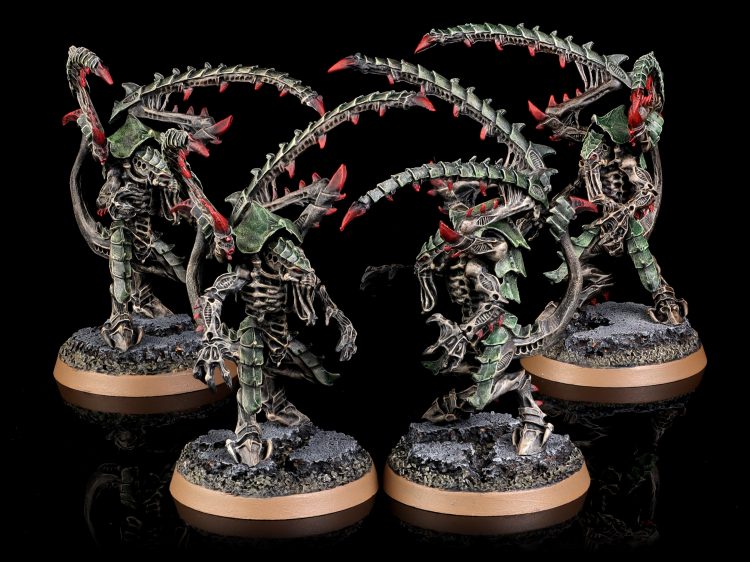
Credit: Pendulin
Also on that theme – Deathleaper (whois an upgraded Lictor). All Lictors took a level in badass, being vastly more deadly than before, becoming untargetable from >12” away if they’re receiving the benefits of cover, getting a 5+ invuln and being able to come in within 6” of the enemy in your own deployment zone. All nice, though they are also twice the price. Deathleaper takes the cake though. He’s even tougher and deadlier than the average Lictor, with more wounds and a 4+ invulnerable save, is a CHARACTER so can be screened or use a Heroic, and prevents anything it’s in Engagement Range of from being selected as the target of any stratagems. Add the Alien Cunning warlord trait for ObSec and counting as 5 models for control, and you’ve got an incredible bargain for 95pts that will give opponents fits.
Continuing on the strong stuff, Tyrant Guard are way tougher and deadlier than they used to be, and can Bodyguard Hive Tyrants now. With multiple ways for a Flyrant to either return to their protection or get out of dodge once it commits, having a unit of these around makes them extremely difficult to take off the table, and these are sufficiently durable (T6, 4W, 2+) that it can be worth bulking the unit out to five models for more coverage and to act as a To The Last option. Depending on your build, these are also great with the Swarmlord as they not only greatly extend its life but being CORE can bully non-ObSec units off objectives with an application of Hive Commander.
The final serious standout here is Zoanthropes, of whom you want one unit a lot of the time. They’re reasonably tough to shift (4+ invulnerable and 4W), add additional volume of psychic viciousness (they boost their casts and damage on smites based on the number of models in the unit) and crucially having them around unlocks the Warp Shielding Synaptic Imperative for the big army-wide invulnerable out of the gate if you lose the roll off. You probably want exactly a three model unit and no more most of the time, but that unit is a big value add (unless you’re already mostly using units with invulnerable saves).
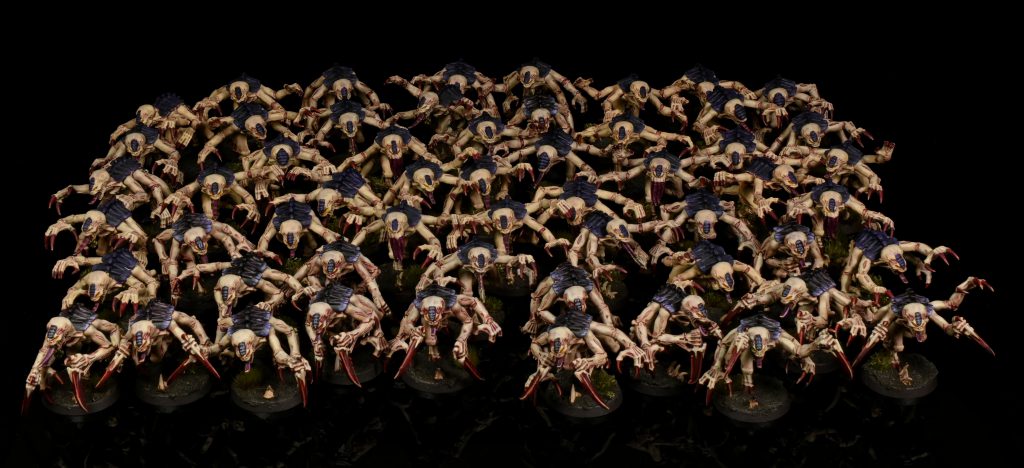
Genestealers are one of the most changed units in the book, and are surprisingly very different to their Purestrain brethren over in Cults. In this book, rather than being super speedy Advance/Charge blenders they’re your Scout deploy unit – they’re still nasty in a fight, hitting with 4A each at AP-3, but don’t get Advance/Charge, and only get a 4+ invulnerable save in melee (5+ at range) so don’t want to get caught in the open. They do have some upgrade options that are worth a look – you can buy them an extended carapace for a 4+ base save in exchange for M7”, and that could be worth it given how you’re likely to set them up (skulking in mid-board cover), and Toxin Sacs for the unit makes them a bit more broadly scary. You can also purchase an Infestation Node marker that they can drop down either when they deploy or as an Action, which adds models back into a nearby unit till it’s removed. It’s very pricy at 20pts and you can’t push the unit size above 10, which makes it a hard sell, but I’m willing to be surprised that there could be some way to make use of it. It seems most likely these show up as minimum squads – Scout deployment is always valuable, and having access to it on the roster is valuable.
The rest of the Elites slot are all good at their jobs, but don’t need particularly deep exploration. Toxicrenes and Venomthropes are both quite a bit more durable, and have a chance to trap enemies in combat, deal them mortals, and make them Fight Last on various d6 rolls. Venomthropes also get 4W, T5 and a 4+ now, making them way better at their job (providing -1 to hit against shooting in a bubble) as opponents can’t just effortlessly flatten them to remove their protection. The Haruspex is still just a battering ram, but a much scarier one. Finally, Pyrovores are low-key one of the most upgraded units in the book – they’re much more durable and way more dangerous, with two flamer modes, one for 2d6 S4 Ap-1 shots and one for d6 AP-2 D2. They’re only 30pts each, and chucking a unit of three into Strategic Reserves presents a pretty real concern for opponents. Importantly, the first mode has an 18” range as well, so they don’t get totally no-sold by Mirror Architect from Harlequins if you do that.
Lots of powerful stuff in Elites overall, a very strong slot for the Hive Mind.
Fast Attack
Two giant worms to start us off here – the Trygon and Mawloc. The Trygon is pretty much the same stat-wise as the Prime over in HQ, so you’re basically paying 30pts less in exchange for not getting Synapse or access to relics/traits. Most uses of the Trygon probably do lean on those, so it doesn’t seem super likely these will get there, but they are pretty cheap as a distraction. The Mawloc, however, is an even cheaper distraction, meaning they’ll likely get the nod if that’s what you want. They’re less directly dangerous in a fight, as their claws are only D1, but they have a mighty 16 attacks, so can scythe through infantry, and have a couple of mortal tricks. The turn before you bring one in from Deep Strike you can basically pre-declare an area where it will arrive and place a marker down, and when it comes in the following turn you have to bring the Mawloc in within 12” of the Marker, but enemies within 6” of it get slammed for Mortals on a 3+ (with boosts for big units). You can also come in within 9” of the enemy at that point, but if you do the monster cannot charge. Bear in mind that you can declare this on your first turn so that the Mawloc can arrive turn 2, so you’re not really losing anything other than some mild restrictions on where you can appear by doing so. Given they also get a chance to deal mortals with a mighty bite when they attack, have all the same defensive options as a Trygon, and rock in at a spicy 125pts, these feel like the distraction unit of choice in this slot.
Gunum: I love(d) the Mawloc, but unfortunately Its new ability is basically the worst version of it we’ve seen. It’s basically an Orbital Bombardment that people will be able to avoid, which makes it a pretty hard sell to me. The one benefit is that it can come up outside of 9” and go for some charges.
A new friend next in the Parasite of Mortrex, a speedy, winged monster that provides you with Synapse and can sting enemy units with its ovipositor to infect them with parasites, turning off their ObSec, dealing them d3 Mortals in their Command Phase, and spawning you a Ripper Swarm if they take at least two wounds. They recover from this half the time, but there’s still plenty of annoyance here, especially as you can infect two units a turn if you use Enfolding Strike as the model moves. The fact that the opponent gets better before the next time they score on a 4+ is the big drawback here, as it means you can’t rely on this working. The model isn’t bad at all, and against enemies using Monsters of their own you can really mess up their movement plans with a well-timed spawn of a Ripper Swarm, but it’s not a must-include when stacked up against the rest of the book.
Speaking of Ripper Swarms, they’ve moved here from Troops and unfortunately that means they don’t have much of a role – they die to a light breeze, they’re not ObSec, and you can’t use them to fill mandatory detachment slots. They’re one of the cheapest full units you can take, and do deep strike, so there’s probably the occasional list that want some just as position holding filler, but don’t expect to see many.
The last “real” choice here is Raveners, who like a lot of the mid-weight infantry have taken a level in badass. They’ve got 4W each, and if you leave them specced as all melee they get 7A each along with rerolls of 1 to hit, which is a whole lot output, especially as they’re S5. It’s unclear whether that ends up as the best way to spend your points, but these are vastly nastier than people are used to now.
The last datasheets in Fast Attack are the two flavours of living bomb, Spore Mines and Mucolid Spores. Both of these are Living Artillery, and thus are largely bypassed for most rule purposes other than either getting shot or blowing opponents up. You can take units of these and deep strike them if you want, but given that pretty much every method of spawning these is now free, that’s overwhelmingly how you’ll go about it.
Heavy Support
The centrepiece of the Heavy Support slot is the Carnifex, a datasheet with a dizzying array of options for upgrades where, it quickly emerges, it’s almost impossible to build a bad one. Most of the time, you’re going to want to go with a heavy venom cannon, enhanced senses, and carnifex crushing claws, which adds up to essentially a redemptor dreadnought without the side arms and defences sidegraded to 9W and a 2+ save for 130pts. Of which you can take nine, because they come in broods.
Hmm. Hmmmmmm.
Realistically you’re more likely to top out a bit lower, because there are other cool things you want to spend points on, but these are an incredible bargain, and there are other valid tweaks you can make. Behemoth can afford to skimp on the crushing claws and go for Adrenal Glands and scything talons so they have volume D3 attacks at S8, and you probably sometimes want to buy Spore Cysts for Light Cover in the open – you can kind of just free associate upgrades and choices here and end up with a model that’s competitive with some of the best monsters out there.
There are also a couple of specialised Carnifex variants you can purchase, with Thornbacks being shootier fexes and the Screamer Killer being a specialised melee monstrosity with 10-11A! Both get a few boosts to their chosen profession, but neither can take the heavy venom cannon, so don’t achieve the level of flexible power the customisable version does. Screamer Killers are probably more likely to see some use, just because they’re so hilariously lethal and get boosted movement to help leverage that.
At the opposite end of the spectrum, Hive Guard are sadly joining Dark Reapers in the prison for units that were too good in 8th Edition. They’re probably not totally out of contention, especially in Kronos, but they’re much, much harder to use because the impaler cannon now only has 24” range (and needs a SYNAPSE unit to spot for it in order to shoot indirectly). The Guard are way more durable, going up to T6 and 4W, so it’s possible you can just have a shockcannon unit shooting in the open, but they’re also not cheap and not-CORE, so it’s really tough not to just spend the points on an additional Carnifex and change.
More positive are the Exocrine and Tyrannofex, the big shooting bugs. Cards on the table – it is still tricky to justify putting points on these rather than more Fexes, but they’re both great datasheets. Both are T8 2+, and their guns have gotten a tuneup – the Exocrine is down in shots once you factor in that it used to shoot twice but those shots are massively better, hitting at S8 AP-4 D3, making it better overall. Exocrines can now move and fire without penalty and only lose an ignore-cover bonus going over half distance. Good news, there’s a strat that can add that back in and causes 6s to explode. Bad news, their gun is Blast now, so getting into engagement range with the enemy is going to deny you shooting for at least a turn. The Tyrannofex does end up losing out on shots from no longer firing twice, but again sees a massive boost on those it does have (as well as BS3+), with the rupture cannon being a monstrous S14 and Dd6+4. The acid spray also jumps to AP-3, and is 6+d6 shots rather than 2d6, so there’s a high floor on the output. The most plausible way to use these is probably one with the spray rushing forward as a wrecking ball, as the defences are sturdy enough that it demands some pretty serious killing.
Last up, Biovores – who aren’t cheap, but might have some play. They also provide indirect fire as long as you have a SYNAPSE spotter, just applying an immediate mortal on a hit, and can choose to perform an Action instead of shooting to drop a unit of Spore Mines with d3 models per Biovore somewhere within 48” thats >6” from enemies. Alternatively, if you have them under the Maleceptor Synaptic Imperative for Action and Shoot, do both! Going near lots of Spore Mines is risky enough that this can be a real deterrent to the enemy, and though the price on these is maybe a little steep, they’re a fun unit to play around with.
Flyer
The Harpy is one of the most terrifyingly pushed datasheets we’ve seen in a long while, and is genuinely an immediate contender for best unit in the entire game – it’s essentially an Archaeopter Stratoraptor and Fusilave stapled together with a melee statline as well. The heavy venom cannon loadout should cost minimum 210pts, so as long as it’s 170pts you should probably put some in your lists if you like winning games. This is a prime candidate for either Dermic Symbiosis or Synaptic Enhancement Adaptive Physiologies, as the former keeps your mighty beast going longer and the latter allows you the benefits of Synaptic Imperatives and also shove Shadow in the Warp down enemy psykers throats early on. Yet another unit where Encircle the Prey is going to come in very handy, either rocketing across the table to get a bead on a hidden target or assaulting in hover mode and then flying off before there’s a reprisal on the subsequent turn.
Gunum: This is the best unit in the book as written. Just insane when we are looking at the amount of firepower coming out of this model.
The Hive Crone is a much more normal all-rounder flyer with some neat tricks against opposing FLY units, but as long as the Harpy exists in its current form there is zero chance you will ever take one in your precious two FLYER slots.
Dedicated Transport
Tyranids get a drop pod in the form of the Tyrannocyte, a beefy affair that stays mobile after landing, brings some guns of its own (though only at BS5+) and can either bring in a lot of small infantry, up to six medium infantry models, or one monster of 16W or less. It can do this turn 1, which rules. While it isn’t cheap, there are definitely some plausible combos one could imagine trying. Six Pyrovores is a pretty vicious autohit fusillade, a Maleceptor could start immediately melting faces, and honestly just 20 Hormagaunts might not be terrible. Whether you ever want to pay a minimum 100pt premium for this is uncertain, but it definitely feels like it’s in the space where it’s good enough if you’re not hyper-optimising, and there might be some specific things you can do that make it in tournament lists.
Fortifications
Just one here, the Sporocyst, and it sits in the comfortable spot where it looks pretty cute and interesting, and does enough that it’ll be fun for casual play without doing anything wildly stupid to the competitive metagame. It’s an immobile Fortification Monster that you can drop in on the board anywhere 12” from the opponent’s deployment zone, it has modest firepower but the same terrible BS5+ as the Tyrannocyte, and can spawn Mucolid Spores or Spore Mines. That’s cool, but an immobile, chargeable unit in no-man’s land is usually a spectacular liability, and it doesn’t do enough for you in a high end list if you keep it at home.
Our Thoughts
How They’ll Play
Monstrously. Our impression of how the most powerful builds are going to play is using Carnifexes as roaming threats that keep the enemy occupied, Harpies as overwhelming fire support, then a mixture of Maleceptors going Mortal Wound crazy and Flyrants using Tyrant Guard and the various evasive strats to stay safe to provide big damage output that’s tricky to respond to.
Those lists should join the top metagame conversation straight, but the good news for players less interested in tournament play is that you can’t go too far wrong with this book – there’s a tonne of flexibility across the army-level options, pretty much every monster has a statline that makes them functional on the tabletop, and hordes of gaunts are still going to be pretty scary if you aren’t having to account for “whoops all airbursts” as a possible counter. The book definitely wants you to be aggressive, and you’re going to get the most out of it when you’re rushing at your opponent and trying to put them on the back foot. Go big, and make the opponent’s army go home.
Hot Takes
![]() Wings: For whatever reason Tyranids have never really clicked for me, and it took me longer to warm to this book than some, but I have ended up liking it quite a bit. I’m a huge fan of the Adaptive subfaction traits as a mechanical concept, and think the designers did a very good job with the actual implementation as well, not always easy on a first outing. I also really like that there’s a bunch of options that all look appealing in the army rules, and while Leviathan does stand out, that’s partially because it has a bunch of extra toys to draw on. Finally, I think most of the datasheets in the book land very well – there’s a whole bunch of monsters you just never saw on the table in 8th that now have functional, effective rules that should be great fun on the table for players that have them in their collections – always a plus.
Wings: For whatever reason Tyranids have never really clicked for me, and it took me longer to warm to this book than some, but I have ended up liking it quite a bit. I’m a huge fan of the Adaptive subfaction traits as a mechanical concept, and think the designers did a very good job with the actual implementation as well, not always easy on a first outing. I also really like that there’s a bunch of options that all look appealing in the army rules, and while Leviathan does stand out, that’s partially because it has a bunch of extra toys to draw on. Finally, I think most of the datasheets in the book land very well – there’s a whole bunch of monsters you just never saw on the table in 8th that now have functional, effective rules that should be great fun on the table for players that have them in their collections – always a plus.
What I don’t like about this book is the stuff that’s too good, and this time around it feels surprisingly and almost jarringly obvious what it is. I expect we’ll end up writing a “what needs a nerf” article for some of this in the fullness of time, and unlike with some of the previous books where there were ominous vibes, but it wasn’t entirely clear what would emerge on top once you layered on all the options, here I feel like I could draft it today and be confident of being 80%+ correct on reviewing it after a month of events. In some ways that may not actually be the worst thing in the world, as a lot of what will be needed is just some point increases, which isn’t hard. It does mean that after next week’s Balance Dataslate (hopefully) takes the existing leaders down a peg we’re probably due some spicy Tyranid win rates for a few months (or habanero turbo spicy if Crusher stays), but bringing things in line will be pretty doable.
That aside, this book feels like a win overall – Tyranids have some of the more challenging themes to translate into rules on the tabletop, and this book pulls that off extremely effectively while also successfully supporting a very deep model range. Top marks on the design, some notes on the balance, but a good addition to the codex canon.
PierreTheMime: Couldn’t have said it better. It’s extremely refreshing to see a Tyranid codex that seems to have a cohesive design right out of the gate. As much as their 8th edition book grew on me, it literally grew by four different supplements and was generally awkward and underpowered barring the obvious top-tier stuff. Now, most units in the book contend for your attention/points and make list design interesting. Everything here reads as dangerous but, almost as importantly, relatively well-balanced and defeatable. Not touched since the dark days of Skyblight Swarm, I’m unironically fielding Gargoyles and Harpies and I’m here for it.
![]() Gunum: It’s no secret I love Nids. I recently was rocking 3 Tyranoctyes and Tervigons and my builds are only going to get worse. I’m focused on two builds right now, one is using Levithan on basically spamming as many Warriors out as possible. The other is Gorgan focused. Being able to wound almost anything on a 4+ suddenly opens up all kinds of abilities for the Nid book. Units of Gaunts, Rippers, and even Gargoyles suddenly can be real threats. Mind you, going in this build direction will prevent abusing the wonders of Crusher Stampede. But you know what? F*ck it. Crusher Stampede is for big babies. The glorious return of Gaunt carpet is upon us.
Gunum: It’s no secret I love Nids. I recently was rocking 3 Tyranoctyes and Tervigons and my builds are only going to get worse. I’m focused on two builds right now, one is using Levithan on basically spamming as many Warriors out as possible. The other is Gorgan focused. Being able to wound almost anything on a 4+ suddenly opens up all kinds of abilities for the Nid book. Units of Gaunts, Rippers, and even Gargoyles suddenly can be real threats. Mind you, going in this build direction will prevent abusing the wonders of Crusher Stampede. But you know what? F*ck it. Crusher Stampede is for big babies. The glorious return of Gaunt carpet is upon us.
![]() Primaris Kevin: I’m a big fan of this book. I feel like the Hive Fleet Adaptations concept works really well for a faction that’s designed to be constantly changing, and the combination of Synaptic Link and Synaptic Imperative are flavorful and fun. Synaptic Imperative is particularly enjoyable because it provides the player with plenty of agency without being overly burdensome in terms of mental load. Adaptive Physiology seems like a bit of a letdown compared to the others, but it’s certainly fine. Overall it seems like the core concepts of Tyranids are fun and viable.
Primaris Kevin: I’m a big fan of this book. I feel like the Hive Fleet Adaptations concept works really well for a faction that’s designed to be constantly changing, and the combination of Synaptic Link and Synaptic Imperative are flavorful and fun. Synaptic Imperative is particularly enjoyable because it provides the player with plenty of agency without being overly burdensome in terms of mental load. Adaptive Physiology seems like a bit of a letdown compared to the others, but it’s certainly fine. Overall it seems like the core concepts of Tyranids are fun and viable.
Probably my biggest complaint about the book is that while plenty of units feel fine, many are overshadowed by a few great units. The Trygon Prime is a good example. It’s cool that it’s a HQ, it’s fun to envision a snake army, and it has a ton of attacks. It’s just not as good as a Hive Tyrant, and the difference is great enough that it makes it challenging not to pick the optimal choice. I expect to see a lot of lists with Maleceptors, Hive Tyrants, Carnifexes, and Harpies. I would be surprised to see units like the Haruspex, Sporocyst, or the Tryon Prime outside of a narrative list. It’s not that those units are bad, it just feels like others are way better.
Fortunately minor datasheet tweaks are fairly easy to embrace. The same can’t be said of Crusher Stampede. It’s simply too good when combined with this book, especially given that for the most part the single wound models seem overcosted and less useful than Tyranid Warriors. I would hope GW would come to their senses and relegate Crusher Stampede to the Open Play dungeon, but if they don’t expect Tyranids to be extremely difficult to displace.
Army Lists
Leviathan Goodstuff
Leviathan Battalion
HQ
Hive Tyrant with Wings, Warlord, Lash Whip and Monstrous Bonesword, Adrenal Glands, Toxin Sacs, Adaptive Biology, Reaper of Obliterax, Paroxysm, Onslaught – 210
Neurothrope, Synaptic Tendrils, Adaptive Neural Lobe, Catalyst, Onslaught – 100
Troops
3 Warriors, 3 Deathspitter, 3 Dual Boneswords – 75
3 Warriors, 3 Deathspitter, 3 Dual Boneswords – 75
10 Gargoyles – 80
Elites
Deathleaper, Alien Cunning – 95
Maleceptor, Psychic Scream, Catalyst – 170
Maleceptor, Enraged Reserves, Neuroparasite, Onslaught – 195
No Slot
5 Tyrant Guard, Adrenal Glands – 215
3 Zoanthropes, Psychic Scream – 150
Heavy Support
Carnifex, Heavy Venom Cannon, 2 Carnifex Crushing Claws, Enhanced Senses – 130
Carnifex, Heavy Venom Cannon, 2 Carnifex Crushing Claws, Enhanced Senses – 130
Flyer
Harpy, 2 Heavy Venom Cannon, Dermic Symbiosis – 195
Harpy, 2 Heavy Venom Cannon, Synaptic Enhancement – 180
2000pts, 9CP
This list is a basic tour through all the best datasheets slammed into a Leviathan shell. It has two Maleceptors who can use Leviathan tricks to go off for massive damage, Harpies for spectacular shooting power, a Flyrant that will flatten almost anything and can’t really be pinned down, and Carnifexes to taste. It has a very strong To The Last plan of Flyrant/Tyrant Guard/boosted Maleceptor (another reason to take Enraged Reserves sometimes, just to get the points up) and some decent ObSec stuff to finish in the Troops and Deathleaper.
PierreTheMime’s Hybrid Kraken
Patrol 0CP
HQ:
Winged Hive Tyrant – 195pts
++Monstrous Bonesword and Lashwhip
++Toxin Sacs
++WLT: Adaptive Biology
++Relic: Chameleonic Mutation
++Powers: Paroxysm, The Horror
Malanthrope – 150pts
++WLT: One Step Ahead (-1CP)
Troops:
10x Gargoyle – 80pts
10x Gargoyle – 80pts
10x Termagant – 70pts
Elites:
3x Zoanthrope – 150pts
++Powers: Psychic Scream
Maleceptor – 170pts
Powers: Psychic Scream, The Horror
Heavy Support:
Exocrine – 195pts
++Dermic Symbiosis
Flyer:
Harpy – 180pts
++2x Heavy Venom Cannon
++Synaptic Enhancement
Patrol -2CP
HQ:
The Swarmlord – 220pts
Powers: Catalyst, Onslaught
Neurothrope – 100pts
++Powers: Neuroparasite, Paroxysm
No slot:
3x Tyrant Guard – 120pts
Troops:
5x Tyranid Warrior – 145pts
++4x Bonesword and Lashwhip
++1x Dual Bonesword
++4x Deathspitter
++1x Venom Cannon
++Adrenal Glands
5x Tyranid Warrior – 145pts
++4x Bonesword and Lashwhip
++1x Dual Bonesword
++4x Deathspitter
++1x Venom Cannon
++Adrenal Glands
Here’s something I think offers a solid hybrid of melee, psychic, and shooting capability. This list makes good use of Gargoyles to accomplish some of the better action-oriented Secondaries and has enough durability and numbers to keep Engage going for a long while. Dipping into two Patrols hurts a little but I think the offensive potential of both a Winged Hive Tyrant and a Swarmlord pays for itself, as well as the capability to bodyguard both with a single durable unit of Tyrant Guard. I’m big on defensive deployment, so while also covering most of the army in a -1 to hit bubble, having both your heavy hitters being untargetable is an easy sell for me. Aside from just generally strong units, the variety gives you a host of great Synaptic Imperatives to choose from. Multiple editions of Venomthropes being easy to snipe out have made me wary of fielding them, but considering how durable they are now I’m strongly considering swapping them in for the Malanthrope. If I were to do that, I’d use the spare points to swap the Termagants for Deathleaper w/ Alien Cunning (it’s a very popular combination for a reason). Some people may raise an eyebrow at the mixed sword/whip on the Tyranid Warriors and that’s an easy answer–that’s what I already had modeled and it also works well enough I don’t feel like reconfiguring them.
The Crusher Stampede Friendmaker
We promised. Gaze upon it and despair.
Leviathan Patrol
HQ
Hive Tyrant with Wings, Warlord, Lash Whip and Monstrous Bonesword, Adrenal Glands, Rampaging Beast, Reaper of Obliterax, Synaptic Barrier, Aggressive Surge – 205
Old One Eye – 220
Troops
3 Warriors, 3 Deathspitter, 3 Dual Boneswords, flesh hooks – 80
Elites
Deathleaper – 95
2 Pyrovores – 60
No Slot
5 Tyrant Guard, Adrenal Glands – 215
Flyer
Harpy, 2 Heavy Venom Cannon, Dermic Symbiosis – 195
Harpy, 2 Heavy Venom Cannon, Synaptic Enhancement – 180
Leviathan Patrol
HQ
Hive Tyrant with Wings, Warlord, Lash Whip and Monstrous Bonesword, Adrenal Glands, Raging Influence, Paroxysm, Onslaught, Synaptic Hive Blades (assuming they get fixed to work with a single sword) – 205
Neurothrope, Synaptic Tendrils, Adaptive Neural Lobe, Catalyst, Onslaught – 100
Troops
3 Warriors, 3 Deathspitter, 3 Dual Boneswords, flesh hooks – 80
Elites
Maleceptor, Psychic Scream, Catalyst – 170
Maleceptor, Enraged Reserves, Neuroparasite, Onslaught – 195
2000pts, 6CP
Wow looks like that’s all we’ve got time for huh.
Gunum: Shame.
Wrap Up
Tyranids look certain to have a big impact on the game, so either get those Carnifexes out of the cabinet or start working out your best bug hunting strategies. Don’t forget to return on Tuesday for the Crusade review!
